
Reading Sample
This selection covers the architecture of SAP EWM, focusing on the delivery
processing component, including storage and retrieval, stock transfer, and
order management, as well as the warehouse logistics component, including
shipping and receiving, warehouse tasks, and warehouse orders.
Peter Zoellner, Robert Halm, Daniela Schapler, Karen Schulze
SAP EWM Architecture and Programming
494 Pages, 2016, $79.95/€79.95
ISBN 978-1-4932-1233-0
www.sap-press.com/3860
First-hand knowledge.
“Delivery Processing”
“Warehouse Logistics”
Contents
Index
The Authors
© 2016 by Rheinwerk Publishing, Inc. This reading sample may be distributed free of charge. In no way must the file be altered, or
individual pages be removed. The use for any commercial purpose other than promoting the book is strictly prohibited.

29
Chapter 2
In order to program in SAP EWM, we must first understand the individ-
ual software components that are part of the installation in the SAP back-
end system. This chapter describes these components in terms of their
function and objects, and concludes by discussing their integration with
SAP ERP.
2 Architecture
The architecture of SAP Extended Warehouse Management (SAP EWM) is charac-
terized by a variety of application components and objects that exhibit the rich
functionality of the system itself. Some of these components will be discussed in
detail with respect to their function and their properties in the following sections
of this chapter:
왘
Delivery processing (see Section 2.1)
The delivery process receives requests for storage and retrieval, as well as
requirements for the transfer of stock, which result from the order manage-
ment. It is therefore closely linked to the SAP ERP system and the components
“Warehousing” and “Transportation Management.”
왘
Warehouse logistics (see Section 2.2)
The warehouse logistics provides a multiplicity of functions that are necessary
for the planning and execution of activities within the warehouse.
왘
Inventory management (see Section 2.3)
The inventory management allows the management of stock in different spatial
and physical states to the level of storage space and parking unit. It is closely
linked with inventory management of SAP ERP.
왘
Quality management (see Section 2.4)
For quality control of inbound goods, SAP EWM provides a close link to Qual-
ity Inspection Engine (QIE).
왘
Integration with SAP ERP (see Section 2.5)
Integration with SAP ERP can be considered a cross-sectional component of
SAP EWM. This section presents the numerous interfaces for the interaction
between SAP ERP and SAP EWM before they are bundled.
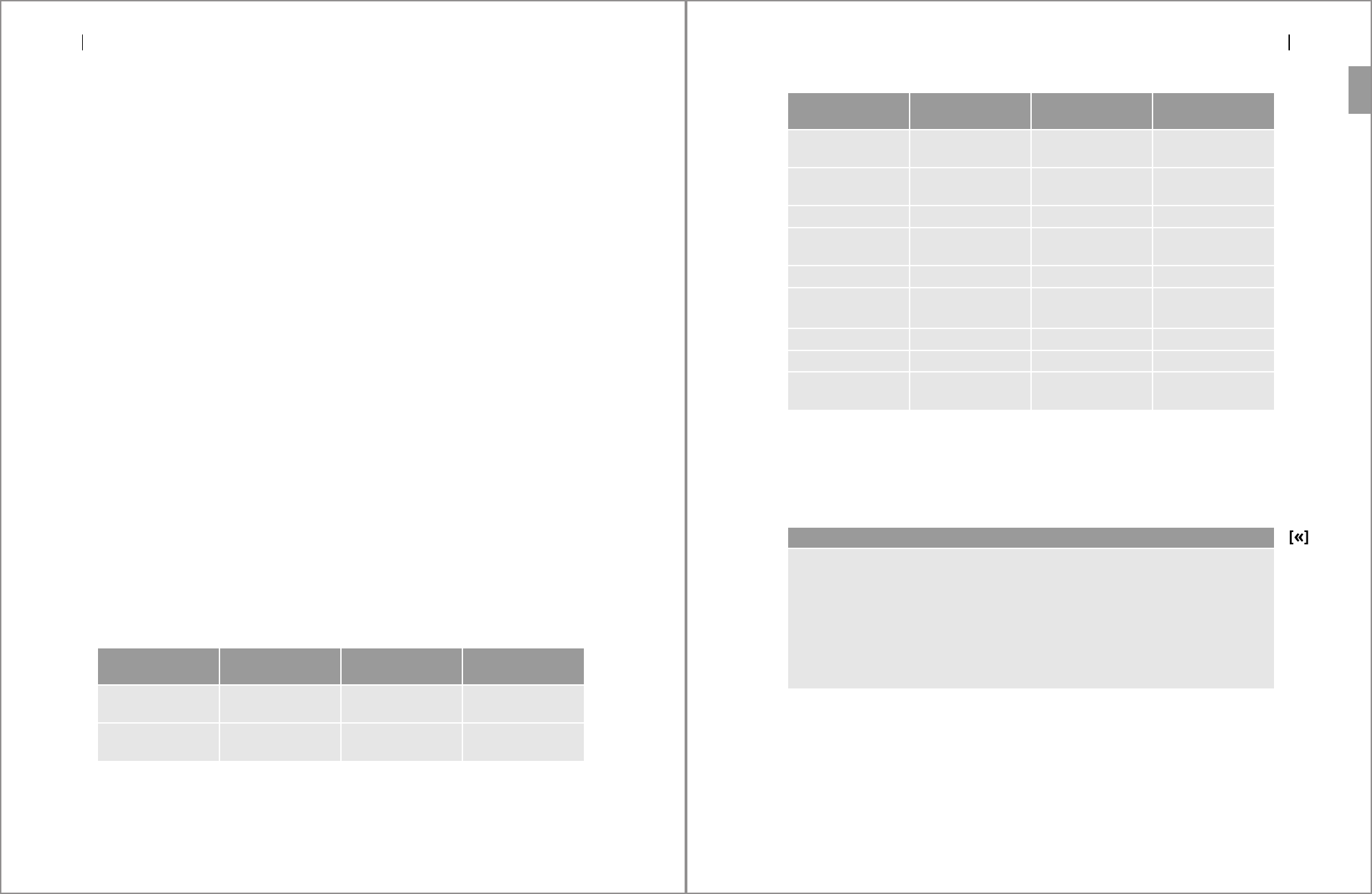
Architecture
2
30
Other components such as labor management, exception handling, master data,
and integration with other SAP and non-SAP systems are not considered in this
chapter, but they are rudimentarily dotted throughout the other chapters.
2.1 Delivery Processing
The delivery in its various forms is one of the key objects in SAP EWM. In this sec-
tion, we explain how this complex object is constructed.
In general, we can say that for SAP EWM every delivery is a warehouse request
(sooner or later), but not every warehouse request is a delivery. You will notice in
SAP EWM that warehouse request is used as the generic term for delivery. How-
ever, within this section, we try to keep them separated to introduce you to dif-
ferent use cases and to avoid confusion.
Economically, the inventory inflows and outflows are usually booked on inbound
deliveries and outbound deliveries in SAP EWM. If you have integrated an SAP
ERP system to SAP EWM, those deliveries in SAP EWM are always created with
reference to a corresponding SAP ERP document.
The delivery in SAP EWM is modeled in several different documents. Depending
on function and processing phases, different forms of documents are used that
will be categorized by the predefined document categories. We distinguish
between delivery documents, which from the perspective of communication with
SAP ERP or other legacy SAP ERP systems are essential, and warehouse requests
(working documents), which are mainly used for processing in SAP EWM.
Table 2.1 provides an overview of all document categories in the delivery/ware-
house request processing used in SAP EWM and calls the central transaction for
each of them.
Document category Description Category SAP EWM
Transaction
IDR Inbound Delivery
Notification
Delivery document /SCWM/IDN
ODR Outbound Delivery
Request
Delivery document /SCWM/ODR
Table 2.1 Overview of Document Categories and Associated /SCWM / UI Transactions
Delivery Processing
2.1
31
In the following section we describe how delivery documents and warehouse
requests are arranged in the logistics overall flow and give you an overview of the
key technical objects.
Production Material Request
Since SAP EWM release 9.2, the Production Material Request (PWR) was introduced as
part of the Advanced Production Integration. The PWR actually does not really fit into
the categories of delivery document or warehouse request. The PWR originates from
the production order in SAP ERP. However, the distribution of this object does not use
the delivery interfaces and also the strict update restrictions for deliveries from SAP ERP
do not apply. Since the PWR is technically treated as a warehouse request in SAP
EWM—more than a delivery document—we decided to categorize it as a warehouse
request within this section.
2.1.1 Function of the Delivery Processing
The delivery processing provides a number of functions to perform various logisti-
cal activities in the warehouse. In particular, it has the task of handling inbound and
outbound postings and triggering the feedback to the respective SAP ERP system.
POR Posting Change
Request
Delivery document /SCWM/IM_DR
GRN Expected Goods
Receipt Notification
Delivery document /SCWM/GRN
PDI Inbound Delivery Warehouse request /SCWM/PRDI
PDO Outbound Delivery
Order
Warehouse request /SCWM/PRDO
SPC Posting Change Warehouse request /SCWM/IM_PC
EGR Expected Goods
Receipt
Delivery document /SCWM/GRPE
/SCWM/GRPI
WMR Stock Transfer Warehouse request /SCWM/IM_ST
FDO Outbound Delivery Delivery document /SCWM/FD
PWR Production Material
Request
Warehouse request /SCWM/PMR
Document category Description Category SAP EWM
Transaction
Table 2.1 Overview of Document Categories and Associated /SCWM / UI Transactions (Cont.)
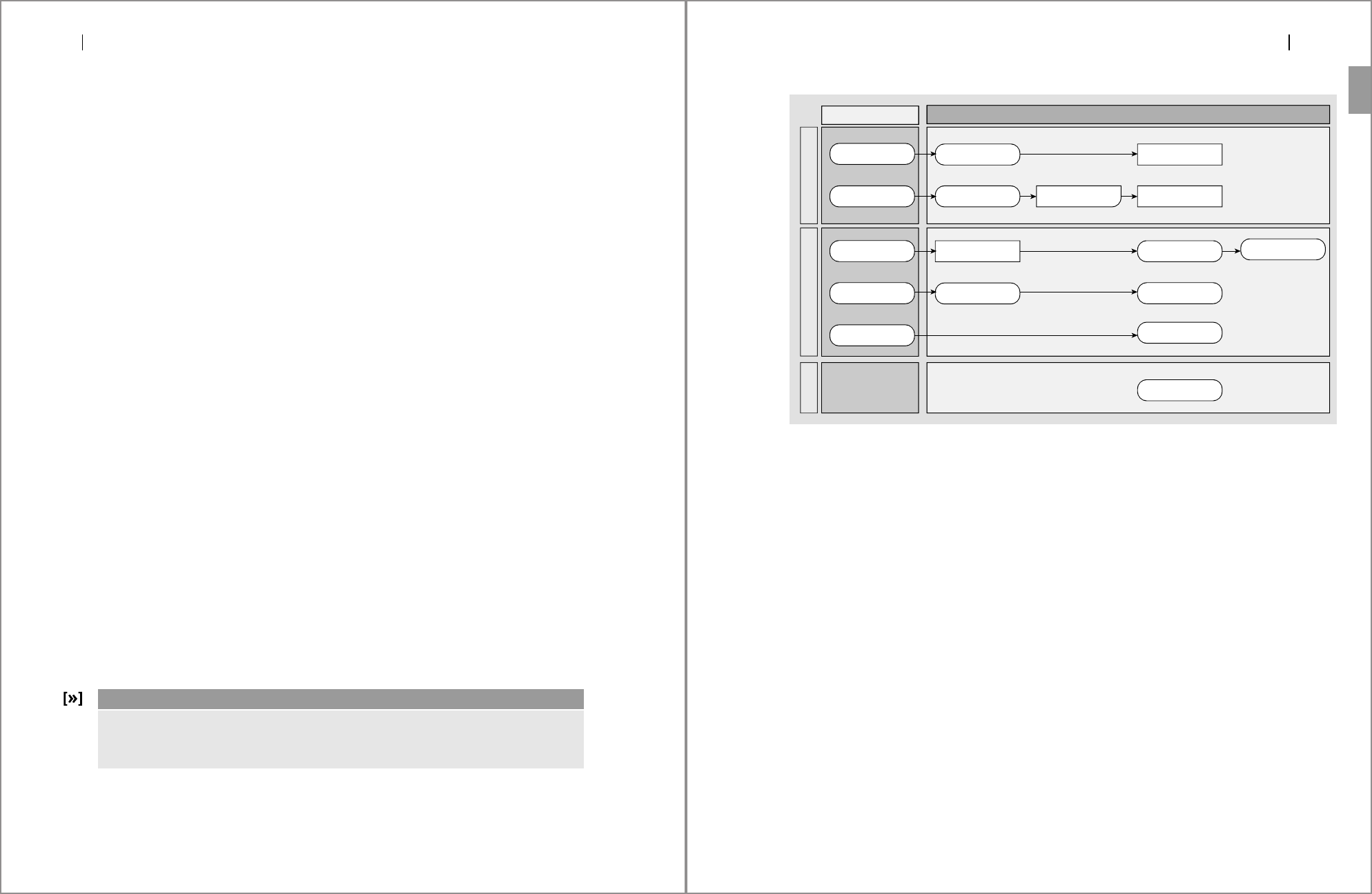
Architecture
2
32
The delivery environment uses documents that are tailor-made for the particular
business context. We will elaborate on these different documents in this section.
In the documents used, we distinguish between delivery documents and warehouse
requests (working documents).
When distributing SAP ERP deliveries to SAP EWM, the delivery documents are
created, from which in turn the warehouse requests are produced using a transfer
service class
/SCDL/CL_TS_MANAGEMENT (method TRANSFER_OBJ). Delivery docu-
ments are used within the warehouse management with SAP EWM as a basis for
the imaging and processing of inbound and outbound processes. On the one
hand, these documents include the data that is necessary for the planning and
scheduling of warehouse activities. On the other hand, data on actions that were
carried out by the system during the delivery processing are updated in these doc-
uments. Thus you always find an overview of the current processing progress of
the relevant document in the system.
The documents to which activities can be carried out within the warehouse (e.g.,
packaging, putaway, picking, etc.) we call warehouse requests (working docu-
ments). Most warehouse requests have preceding documents. The preceding doc-
uments are a kind of template for the creation of warehouse requests. That is,
based on the data of the preceding document, the SAP EWM-specific information
from customizing (for example, document categories, item categories, warehouse
process types, etc.) and master data (e.g., warehouse product, storage bin, batch,
etc.) will be read in order to enrich the warehouse request accordingly.
For a schematic overview of the relationship between delivery documents and
warehouse requests, see Figure 2.1; it shows what delivery objects from an SAP
ERP system produce which delivery documents and the resulting warehouse
requests according to the logistical process.
Regarding the technical document architecture, however, there is no difference
between warehouse requests and delivery documents. Technically, all documents
in the delivery environment are built identically.
Delivery Processing in SAP EWM
For more information about supported processes and requirements for delivery process-
ing in SAP EWM and references to the configuration options, see SAP Help Portal
(http://help.sap.com/EWM92).
Delivery Processing
2.1
33
Figure 2.1 Relationship between Delivery Documents and Warehouse Requests
2.1.2 Object Warehouse Request and Data Model
In SAP EWM, the deliveries and warehouse requests are modeled as ABAP
Objects. By reading deliveries, the objects (instances) are created that represent
the respective deliveries. This object instance can then be accessed by writing, for
example, to change delivery dates.
In addition to pure reading of database data, yet more automatic processes occur
during the reading process or while the instances are created; among other func-
tions, determinations and validations are performed on the object instances to set
dynamic data (for example, aggregated quantities, status, etc.).
Business Object Processing Framework
In this context, we briefly explain the Business Object Processing Framework (BOPF)
and the way determinations, validations, and actions to SAP EWM delivery objects
are used. The BOPF is in its present form a framework for the implementation of
business objects, following the principles of Service-Oriented Architecture (SOA).
SAP EWM
SAP ERP
Inbound Delivery
Inbound Delivery
Notification (IDR)
Purchase Order /
Production Order
Outbound Delivery
Outbound Delivery
Expected Goods Receipt
Notification(GRN)
Expected Goods
Receipt (EGR)
Inbound Delivery (PDI)
Outbound Delivery
Request (ODR)
Outbound Delivery
Order (PDO)
Outbound
Delivery (FDO)
Posting Change
Request (POR)
Posting Change
(SPC)
InboundOutbound
Stock Transfer (WMR)
Internal
Inbound Delivery (PDI)
Production Order
Production Material
Request (PWR)
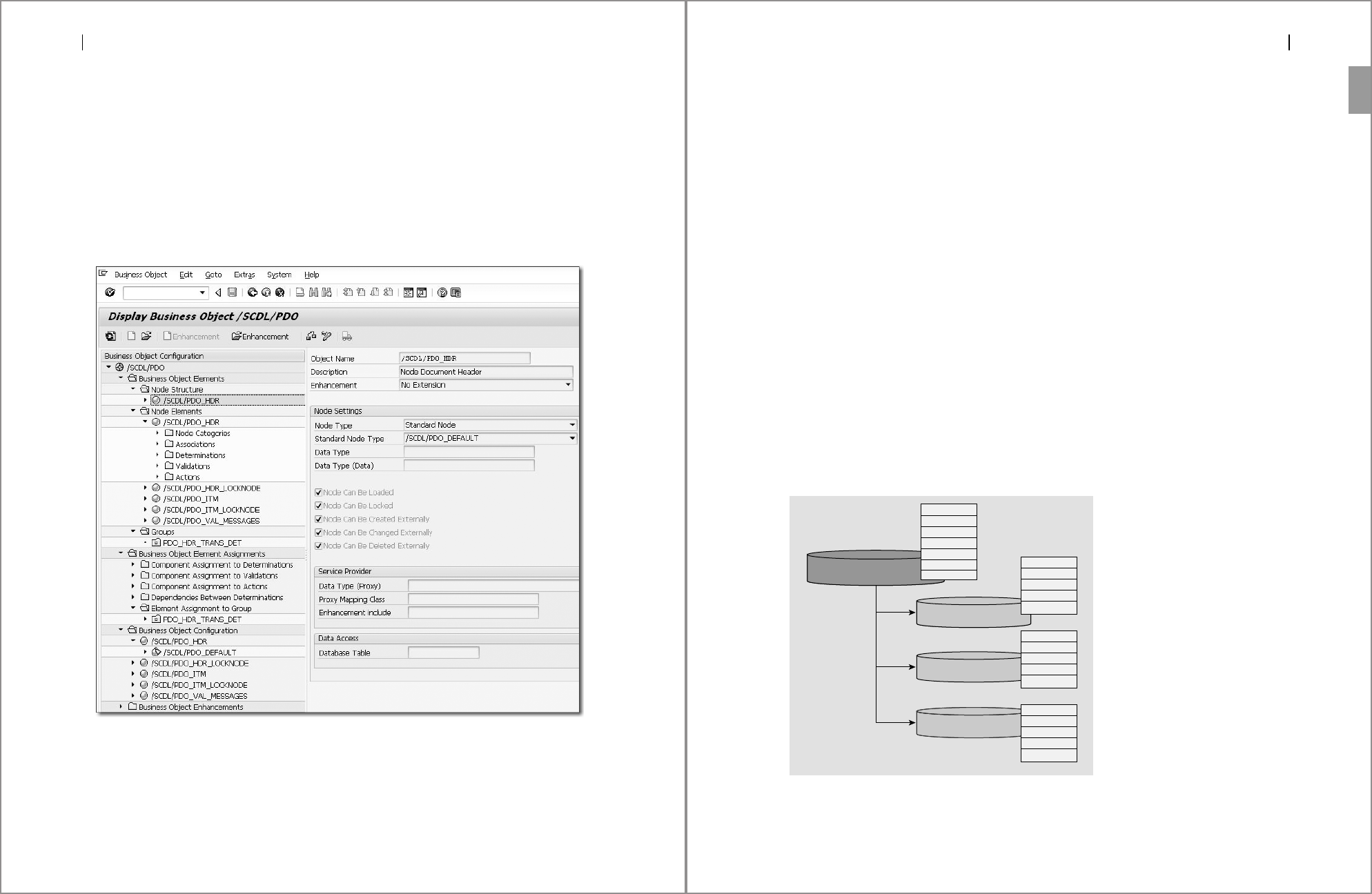
Architecture
2
34
It contains the necessary functions for implementation and supports a uniformly
usable modeling standard. The SOA concept is based basically on Enterprise Ser-
vices, which underlie a strict governance process to ensure the necessary uniform
business semantics of existing applications and beyond. The Enterprise Services
delivered by SAP are structured along business processes and can be assembled
into an automated flow.
The BOPF controls the business logic of the application and covers the deploy-
ment, the buffering, and the storage of data.
Figure 2.2 BOPF UI to Object /SCDL/PDO
Hence business logic and data management are strictly separated, as well as
modification and checking of the data managed. From the software application
Delivery Processing
2.1
35
platform (AP) layer perspective, today’s BOPF, as it is used in various SAP prod-
ucts (e.g., SAP Transportation Management), is no longer compatible with the SAP
EWM BOPF; however, the basics are still recognizable in delivery processing. Via
Transaction /BOPF/CONF_UI, an insight into the clearly structured modeling of
the various document categories of SAP EWM delivery processing is provided
(see Figure 2.2).
Construction of the Delivery
A delivery always consists of a delivery header and at least one delivery item. The
technical relationship is produced by the key holding the
DOCID (unique internal
header identification) and the
ITEMID (unique internal item identification). In
addition, other properties are assigned by default as well:
왘 Status
왘 Dates
왘 Reference documents
왘 Aggregated quantities
왘 Locations
왘 Business partners
Figure 2.3 Construction of a Delivery Object in SAP EWM
Item 1
DOCID – ITEMID
Header
DOCID
Item 2
DOCID – ITEMID
Item N
DOCID – ITEMID
STATUS
ADDMEAS
DATES
TRANSPORT
REFDOC
EEW
...
STATUS
ADDMEAS
DOCFLOW
EEW
...
STATUS
ADDMEAS
DOCFLOW
EEW
...
STATUS
ADDMEAS
DOCFLOW
EEW
...
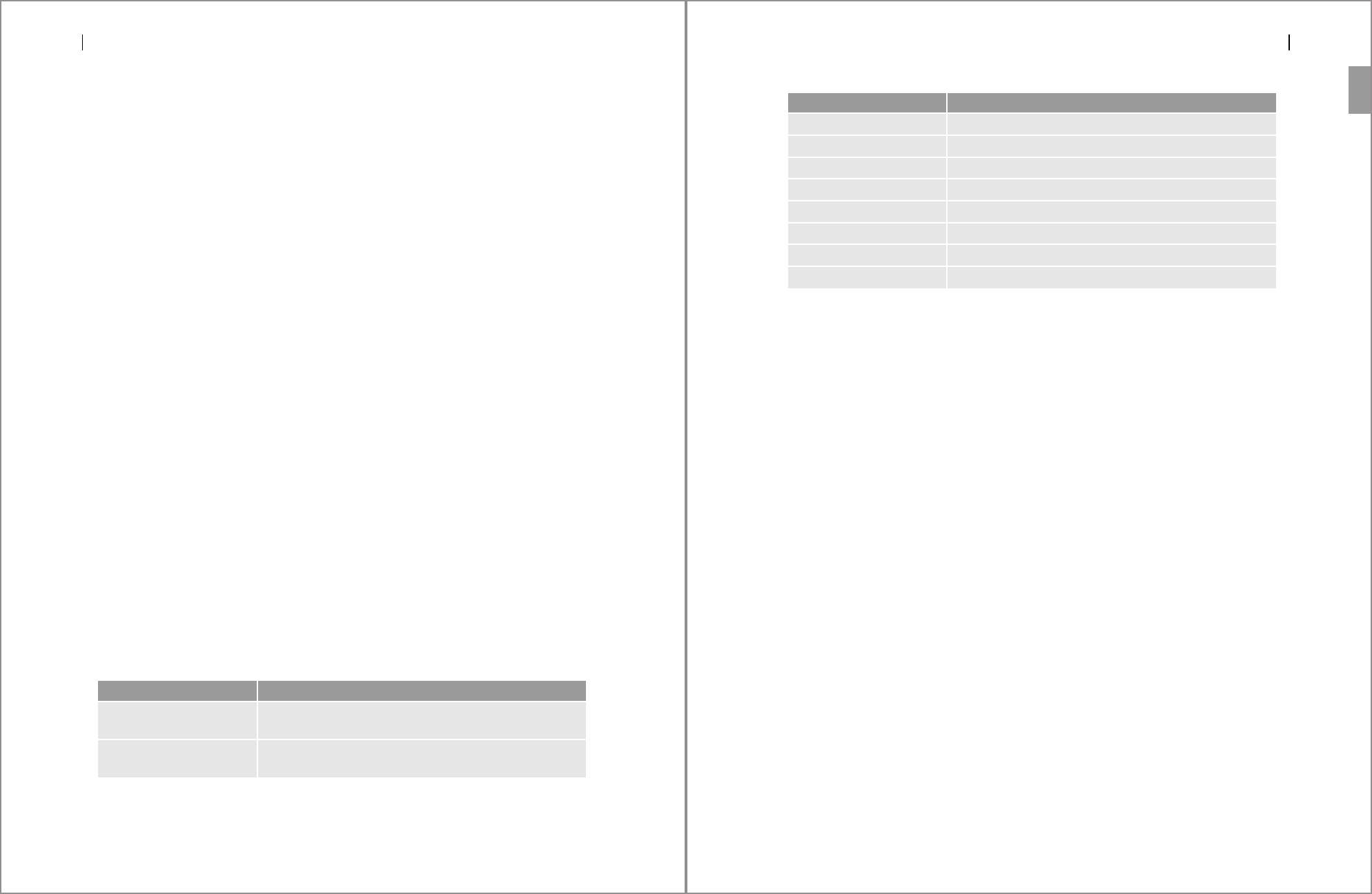
Architecture
2
36
Additional properties that you can use optionally, such as handling units, trans-
portation units, texts, etc., are also assigned from the corresponding applications
to the delivery document. Figure 2.3 shows the construction of the delivery.
The document categories at the header level are the item categories at the item
level. These attributes are the basis on which the business properties of each posi-
tion are categorized.
There are the following seven types:
왘 DLV: Standard Delivery Item
왘 PAC: Packing Item
왘 RET: Returns Item
왘 TXT: Text Item
왘 VAL: Value Item
왘 CMP: Component (PWR)
왘 OCP: Outbound Component (PWR)
In addition, at the item level, among others, the following hierarchy elements are
distinguished:
왘 Main Item (DSP)
왘 Batch Split Item (BSP)
왘 Delivery Split Item (FSD)
The split items can occur in SAP EWM, for example, when you post the goods
issue only for a specific item and not for the entire delivery (delivery split) or
when you pick different batches for one single main item (batch split). Split items
are always in a fixed hierarchy to the main item.
Table 2.2 shows the main database tables for header and item data in the delivery
processing. For more database tables on the objects mentioned, you can check the
package
/SCDL/DATA_MODEL.
Database Table Description
/SCDL/DB_REQH Inbound Delivery Notification / Outbound Delivery
Request: Header
/SCDL/DB_REQI Inbound Delivery Notification/ Outbound Delivery
Request: Item
Table 2.2 Important Database Tables of Delivery
Delivery Processing
2.1
37
The structure and the concept of SAP EWM delivery processing allows us to
access individual items and extrapolate them without locking the entire ware-
house request. This has, in practice, the great advantage of allowing different
items of a warehouse request to be worked in parallel—for example, during pick-
ing—and still no lock conflicts will be triggered.
From a performance point of view, this also results in a further advantage: pro-
cesses within the delivery processing and the work at item level only load the
respective item and not all of the other items of the relevant warehouse request in
the memory.
Service Provider and Aspects
In order to allow all applications in SAP EWM to access a delivery object via a
central interface, the Service Provider (SP) is used. These SPs provide interface
methods that enable the application to read, write, and execute actions to a spe-
cific business object (BO). Also, the SPs serve to return the requested data from the
BO well prepared in the respective structures of the calling application. This
architecture allows a generic use of the BO, tailored to the specific requirements
of each SAP EWM application.
The two central SPs in SAP EWM are:
왘
/SCDL/CL_SP: SP of the delivery
왘
/SCWM/CL_SP: SP of the user interface (UI)
/SCDL/DB_PROCH_I Inbound Delivery: Header
/SCDL/DB_PROCI_I Inbound Delivery: Item
/SCDL/DB_PROCH_O Outbound Delivery Order: Header
/SCDL/DB_PROCI_O Outbound Delivery Order: Item
/SCDL/DB_DLVH_O Outbound Delivery: Header
/SCDL/DB_DLVI_O Outbound Delivery: Item
/SCDL/DB_PROCH_P Production Material Request: Header
/SCDL/DB_PROCI_P Production Material Request: Item
Database Table Description
Table 2.2 Important Database Tables of Delivery (Cont.)
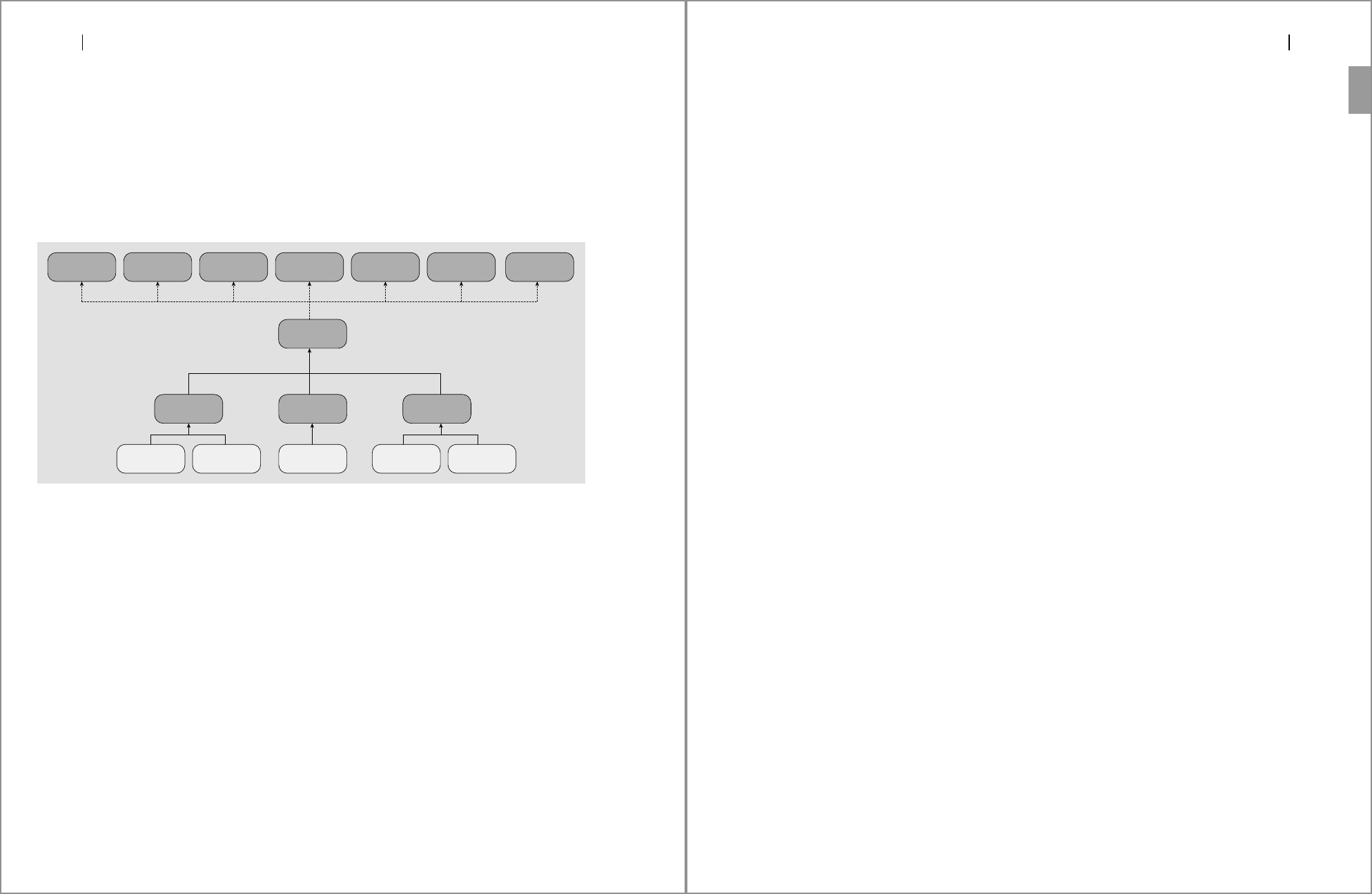
Architecture
2
38
These abstract classes, with their interfaces, build the foundation for the special
use cases within the delivery processing. Here the main difference between
/SCDL/
CL_SP
and /SCWM/CL_SP is that the SPs of the UI—depending on the particular
transaction—hide diverse fields or components of the BO and they perform addi-
tional checks (ABAP logics) before updating the object. Furthermore, the object
data through the UI SP will also be enriched by short descriptions. The various
forms of the delivery SP are shown graphically in Figure 2.4.
Figure 2.4 Architecture of the SPs /SCDL CL_SP
The structures by which the SPs communicate with the application programs are
called aspects. An aspect represents a specific attribute of the BO. There is, for
example, an aspect for dates data at header level (
/SCDL/S_SP_A_HEAD_DATE) and
an aspect for dates data at item level (
/SCDL/S_SP_A_ITEM_DATE).
In the architecture of the Enterprise Service we distinguish between key aspects
and aspects. Here, the key aspect always contains the semantic key of an object
(similar to a primary key). All aspects must be assigned to a key aspect to be
clearly identifiable.
There are no specific repository objects to the respective aspects, so to accommo-
date the highly dynamic approach of this architecture, the caller has to ensure
that the desired context will be passed when calling the SP methods. The appro-
priate definitions can be found as constants within the interfaces
/SCDL/IF_SP_C
/
SCDL/IF_SP1_ACTION
/
SCDL/IF_SP1_ASPECT
/SCDL/IF_SP1_
LOCKING
/SCDL/IF_SP1_QUERY
/SCDL/IF_SP1_
TRANSACTION
/SCDL/IF_SP_
QUERY_ID
/SCDL/IF_SP_BADI
/SCDL/CL_SP
/SCDL/CL_SP_DR /SCDL/CL_SP_FD /SCDL/CL_SP_PRD
/SCDL/CL_SP_
DR_OUT
/SCDL/CL_SP_
DR_INB
/SCDL/CL_SP_
FD_OUT
/SCDL/CL_SP_
PRD_INB
/SCDL/CL_SP_
PRD_OUT
Delivery Processing
2.1
39
and /SCWM/IF_SP_C. The coding example in Listing 2.1 will give you an example
of how to use the most important aspects and SP methods. First, we create objects
with reference to the classes
/SCDL/CL_SP_PRD_OUT and /SCDL/CL_SP_MESSAGE_BOX.
We use class
/SCDL/CL_SP_PRD_OUT because we will select an outbound delivery
order. The message box will be needed to capture any messages, for example, in
case of errors.
DATA: lo_sp TYPE REF TO /scdl/cl_sp_prd_out,
lo_message_box TYPE REF TO /scdl/cl_sp_message_box.
TRY.
CREATE OBJECT lo_message_box.
CREATE OBJECT lo_sp
EXPORTING
io_message_box = lo_message_box
iv_doccat = /scdl/if_dl_doc_c=>sc_doccat_out_prd
iv_mode = /scdl/cl_sp=>sc_mode_classic.
ENDTRY.
Listing 2.1 Create Object Instance
Now we select an ITEM aspect using an SAP ERP delivery number and the item
number. We illustrate how this works in Listing 2.2. In the following section, we
explain what is happening with the complex selection criteria.
DATA: ls_options TYPE /scdl/s_sp_query_options,
ls_inparam TYPE /scdl/s_sp_q_head,
lt_selections TYPE /scdl/t_sp_selection,
ls_selections TYPE /scdl/s_sp_selection,
lt_a_item TYPE /scdl/t_sp_a_item,
lv_rejected TYPE boole_d,
lt_return_codes TYPE /scdl/t_sp_return_code,
lt_messages TYPE /scdl/dm_message_tab.
ls_selections-fieldname = /scdl/if_dl_logfname_c=>sc_refdocno_erp_h.
ls_selections-sign = 'I'.
ls_selections-option = 'EQ'.
ls_selections-low = '8040000094'.
APPEND ls_selections TO lt_selections.
CLEAR ls_selections.
ls_selections-fieldname = /scdl/if_dl_logfname_c=>sc_refitemno_erp_i.
ls_selections-sign = 'I'.
ls_selections-option = 'EQ'.
ls_selections-low = '10'.
APPEND ls_selections TO lt_selections.
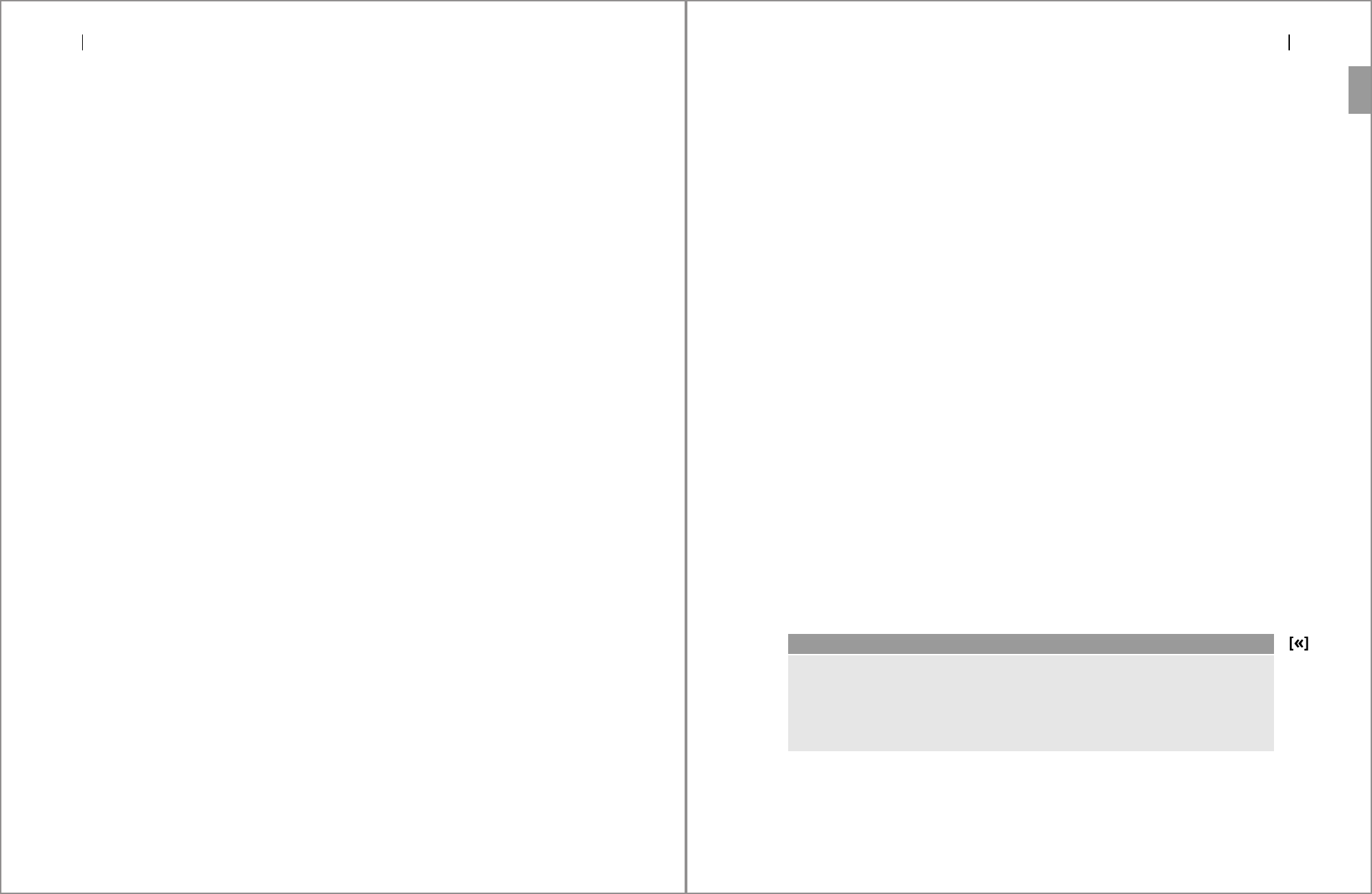
Architecture
2
40
lo_sp->query( EXPORTING
query = /scdl/if_sp_c=>sc_qry_item
selections = lt_selections
IMPORTING
outrecords = lt_a_item
rejected = lv_rejected ).
IF lv_rejected = abap_true.
lt_messages = lo_message_box->get_messages( ).
CALL METHOD /scwm/cl_tm=>cleanup( ).
EXIT.
ENDIF.
Listing 2.2 Example Calling "/SCDL/IF_SP1_QUERY~EXECUTE"
The returning value lt_a_item holds both the DOCID and the ITEMID. Both values
are needed to continue using the key aspect
lt_sp_k_item. Next we can select the
aspect for our item, which includes the delivery terms (see Listing 2.3).
DATA: ls_sp_k_item TYPE /scdl/s_sp_k_item,
lt_sp_k_item TYPE /scdl/t_sp_k_item,
lt_a_item_delterms TYPE /scdl/t_sp_a_item_delterm.
FIELD-SYMBOLS:
<fs_a_item> TYPE /scdl/s_sp_a_item.
READ TABLE lt_a_item ASSIGNING <fs_a_item> INDEX 1.
IF sy-subrc EQ 0.
MOVE-CORRESPONDING <fs_a_item> TO ls_sp_k_item.
APPEND ls_sp_k_item TO lt_sp_k_item.
ENDIF.
lo_sp->select( EXPORTING
inkeys = lt_sp_k_item
aspect = /scdl/if_sp_c=>sc_asp_item_delterm
IMPORTING
outrecords = lt_a_item_delterms
rejected = lv_rejected
return_codes = lt_return_codes ).
IF lv_rejected = abap_true.
lt_messages = lo_message_box->get_messages( ).
CALL METHOD /scwm/cl_tm=>cleanup( ).
EXIT.
ELSEIF lt_return_codes IS NOT INITIAL.
READ TABLE lt_return_codes TRANSPORTING NO FIELDS
WITH KEY failed = 'X'.
IF sy-subrc IS INITIAL.
lt_messages = lo_message_box->get_messages( ).
Delivery Processing
2.1
41
CALL METHOD /scwm/cl_tm=>cleanup( ).
EXIT.
ENDIF.
ENDIF.
Listing 2.3 Example Calling "/SCDL/IF_SP1_ASPECT ~ SELECT"
If you have extended the delivery item with its own customer fields and you want
to read or update these fields, you use the aspect
SC_ASP_ITEM_EEW_PRD instead of
SC_ASP_ITEM_DELTERM. If you do not want to provide a specific item of the deliv-
ery or if you first want to determine the corresponding items, you use the call in
Listing 2.4.
lo_sp->select_by_relation( EXPORTING
relation = /scdl/if_sp_c=>sc_rel_head_to_item
inrecords = lt_sp_k_head
aspect = /scdl/if_sp_c=>sc_asp_head
IMPORTING
outrecords = lt_a_item
rejected = lv_rejected
return_codes = lt_return_codes ).
Listing 2.4 Example Calling "/SCDL/IF_SP1_ASPECT~SELECT_BY_RELATION"
We recommend using aspects only if you have to select certain pieces of informa-
tion of a delivery object or if you want to update certain customer fields. You
should have these features override standard values only in exceptional cases and
only if you are absolutely sure what effect this will have, otherwise, data incon-
sistencies may occur.
In general, however, a delivery object needs various information from various
aspects. To this end, there are other functions, which we will explain in the next
section.
Additional Information
왘 For more information about the data model, as well as the technical objects, please
check the SAP Service Marketplace (http://service.sap.com).
왘 In the guidelines attached to SAP Note 1414179, there are detailed technical
descriptions on the used class interfaces and the service classes of delivery process-
ing, as well as numerous coding examples.
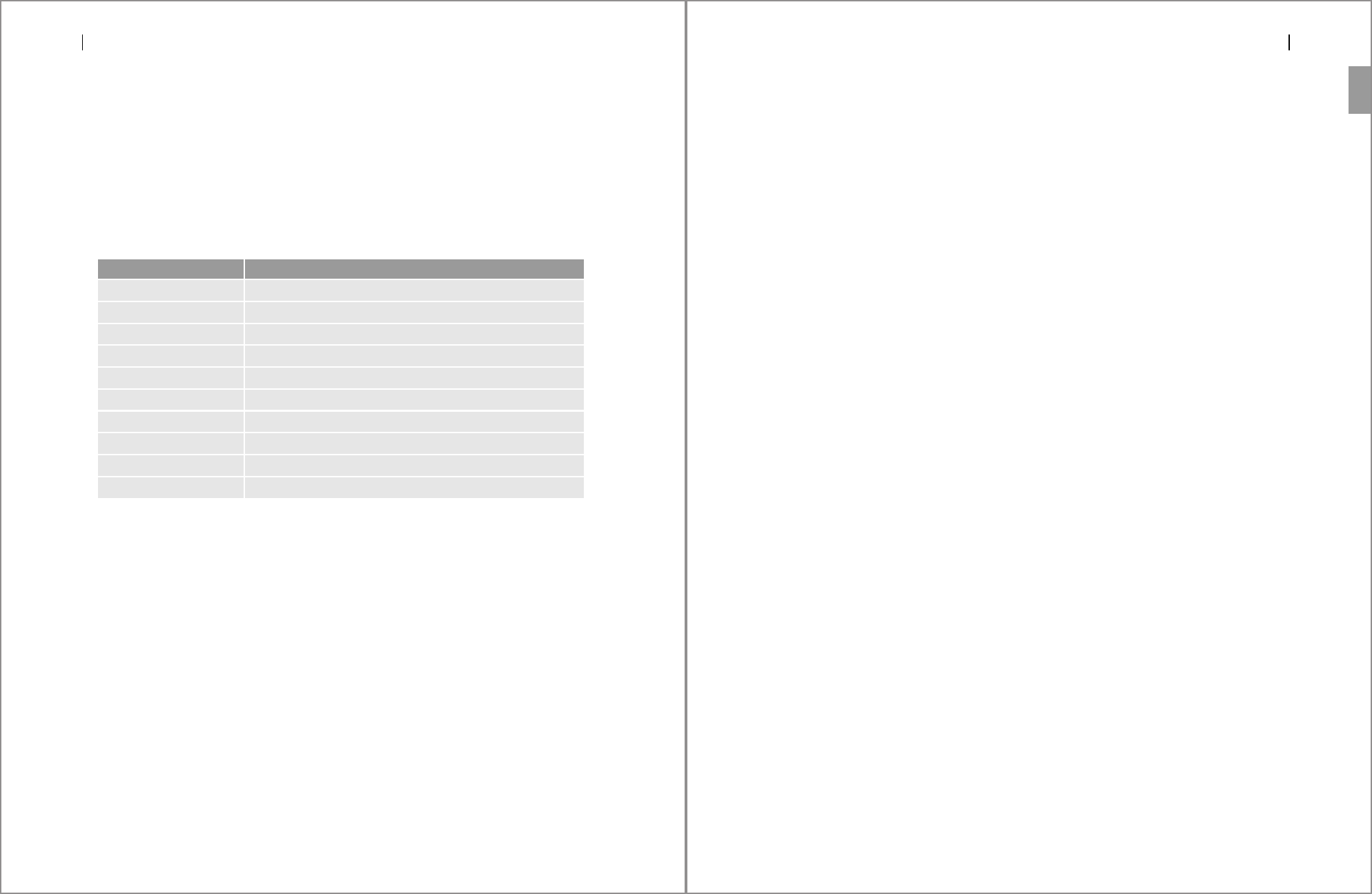
Architecture
2
42
Using the Delivery Query
To select delivery documents or warehouse requests without having to use indi-
vidual aspects directly, SAP provides the method
QUERY. This method is part of the
three main classes of the object manager
/SCWM/CL_DLV_MANAGEMENT. Depending
on the document category you want to select, you will need to use the designated
class. Inbound delivery notifications, for example, are read with a class other than
inbound deliveries. Table 2.3 shows the class reference you should use in order to
select the objects according to each document category using the method
QUERY.
The coding example in Listing 2.5 will help you understand how you can use the
delivery query to read the header and item information of an outbound delivery order
for an SAP ERP delivery number on complex selection criteria (
LT_SELECTION).
DATA:
lo_delivery TYPE REF TO /scwm/cl_dlv_management_prd,
lo_message TYPE REF TO /scwm/cl_dm_message_no,
lt_message TYPE /scdl/dm_message_tab,
lx_delivery TYPE REF TO /scdl/cx_delivery,
lt_selection TYPE TABLE OF /scwm/dlv_selection_str,
ls_selection TYPE /scwm/dlv_selection_str,
ls_addmeas_detail TYPE /scdl/dl_addmeas_key_str,
ls_read_options TYPE /scwm/dlv_query_contr_str,
ls_include TYPE /scwm/dlv_query_incl_str_prd,
lt_headers TYPE /scwm/dlv_header_out_prd_tab,
lt_items TYPE /scwm/dlv_item_out_prd_tab.
Document category Class
IDR /SCWM/CL_DLV_MANAGEMENT_DR
ODR /SCWM/CL_DLV_MANAGEMENT_DR
POR /SCWM/CL_DLV_MANAGEMENT_DR
EGR /SCWM/CL_DLV_MANAGEMENT_DR
PDI /SCWM/CL_DLV_MANAGEMENT_PRD
PDO /SCWM/CL_DLV_MANAGEMENT_PRD
SPC /SCWM/CL_DLV_MANAGEMENT_PRD
WMR /SCWM/CL_DLV_MANAGEMENT_PRD
FDO /SCWM/CL_DLV_MANAGEMENT_FD
PWR /SCWM/CL_DLV_MANAGEMENT_PRD
Table 2.3 Document Categories and Associated Query Classes
Delivery Processing
2.1
43
* get instance
lo_delivery = /scwm/cl_dlv_management_prd=>get_instance( ).
* build up range of select options
ls_selection-fieldname =
/scdl/if_dl_logfname_c=>sc_refdocno_erp_h.
ls_selection-sign = 'I'.
ls_selection-option = 'EQ'.
ls_selection-low = '8040000090'.
APPEND ls_selection TO lt_selection.
* set read options
ls_read_options-data_retrival_only = abap_true.
ls_read_options-mix_in_object_instances = /scwm/if_dl_c=>sc_mix_in_
load_instance.
ls_include-item_addmeas = abap_true.
ls_include-item_status = abap_true.
ls_include-item_hierarchy = abap_true.
* call DLV query
TRY.
CALL METHOD lo_delivery->query
EXPORTING
iv_doccat = /scdl/if_dl_c=>sc_doccat_out_prd
it_selection = lt_selection
is_read_options = ls_read_options
is_include_data = ls_include
IMPORTING
et_headers = lt_headers
et_items = lt_items
eo_message = lo_message.
IF lo_message IS BOUND.
lt_message = lo_message->get_messages( ).
ENDIF.
CATCH /scdl/cx_delivery INTO lx_delivery.
IF lx_delivery->mo_message IS BOUND.
lo_message->add( lx_delivery->mo_message ).
ENDIF.
ENDTRY.
Listing 2.5 Example Calling “Delivery Query”
If you would like to use complex selection criteria, you must know the association
between the corresponding database fields—in our example, the SAP ERP deli-
very number—and the logical field names. For this mapping, see the IMG on
EWM 폷 Cross-Process Settings 폷 Delivery Processing 폷 Extend Delivery Pro-
cessing 폷 Define Logical Field Names.

Architecture
2
44
Alternatively, the constants for the logical field names are to be found in the fol-
lowing interfaces:
왘
/SCDL/IF_DL_LOGFNAME_C
왘 /SCWM/IF_DL_LOGFNAME_C
As a result, the system provides even further delivery-related information next to
the header or item data. Depending on the class used, this can be, for example,
assigned handling units or transportation units.
The selection of delivery objects can have a strong impact on the performance of
a process in certain circumstances. That depends not only on how many docu-
ments and items there are to be read but also on what states or values from the
database information must be calculated at runtime. Special header and item
information—for example, status values and quantity roles—are dynamic (tran-
sient state) and have to be calculated at runtime based on other static values (per-
sistent state). You can find an overview of the characteristics of a status here in
IMG EWM 폷 Cross-Process Settings 폷 Delivery Processing 폷 Status Manage-
ment 폷 Define Status Profiles.
Note that there could be different configurations to a status at header and item
level. For example, for outbound delivery orders, the status
DPI (Picking) at item
level is persistent. Whereas at the header level, it is calculated at runtime from the
status of the items; therefore, the status here is transient.
In order to control the selection behavior of the delivery query to the specific
needs, SAP delivers the following structures as import parameters:
왘
IS_READ_OPTIONS – controls the selection behavior
왘
IS_INCLUDE_DATA – include certain aspects
왘
IS_EXCLUDE_DATA – exclude certain aspects
The
IS_EXCLUDE_DATA parameter is, however, obsolete and only mentioned here to
provide comprehensive information. You should not use it in implementations.
In your programming, you should closely examine in each context exactly what
you need the delivery object for (read or write accesses). In addition, check if the
data in the selection result are really necessary.
Delivery Processing
2.1
45
Query Control during Data Acquisition
In an evaluation for special deliveries, you want to determine for which of these docu-
ments the goods issue has already been posted. The status to check for at item level is
called
DGI and is persistent. You call therefore the delivery query for a read-only access
and you need only
ET_ITEMS as a return parameter. A creation of an object instance and
the calculation of dynamic values are not necessary. Accordingly, you can use the indi-
cator
DATA_RETRIVAL_ONLY in the structure IS_READ_OPTIONS and you will set struc-
tural value
IS_INCLUDE_DATA-ITEM_STATUS.
A detailed description of how to use the special reading options can be found in the
documentation of the method
QUERY in the class /SCWM/CL_DLV_MANAGEMENT_PRD. In
any case, you should always set the appropriate reading options before every call of the
delivery query due to performance reasons.
Another fundamental part of deliveries are the respective item quantities. SAP
EWM provides various functions for editing delivery items, which the status
management cannot solely manage. For example, one would like to know exactly
how much has not yet been posted by the system during a partial goods receipt—
that means how much is still open. This aspect will be displayed using single
quantity roles.
You can find the current quantities of a delivery item in the delivery UI under the
table tab ADDL QUANTITIES. Similar to the status management, the quantity off-
setting also contains persistent and transient values. For example, the quantity
role
W1 (Picking Planned) will be calculated from the document flow of an item at
runtime.
The delivery document flow is technically a separate framework, which is why
we will not go into it in greater detail at this point. Basically, it represents node
relationships that contain information on specific actions to a delivery item. The
document flow used a very flat database layer (
/1DF/* tables) up until SAP EWM
release 7.02. Release SAP EWM 9.0 introduced the advanced document flow.
Thus here the information is not stored in the
/1DF/* tables anymore but in a few
generic ones (one/two) to improve performance.
An overview of the properties of all quantities roles as well as their determina-
tion, see the IMG EWM 폷 Cross-Process Settings 폷 Delivery Processing 폷 Quan-
tity Offsetting.

Architecture
2
46
The example in Listing 2.6 shows how to evaluate item hierarchy, status, and
quantity roles. We use the already selected table
lt_items and examine first
whether there are delivery split items.
DATA: ls_addmeas TYPE /scdl/dl_addmeas_str,
ls_status TYPE /scdl/dl_status_str.
DATA: ls_hierarchy TYPE /scdl/dl_hierarchy_str,
lv_cat TYPE /scdl/dl_hierarchy_category,
lv_skip TYPE boolean,
lo_corr TYPE REF TO /scwm/cl_dlv_correlation.
FIELD-SYMBOLS: <item> TYPE /scwm/dlv_item_out_prd_str.
LOOP AT lt_items ASSIGNING <item>.
* check hierarchy
lo_corr = /scwm/cl_dlv_correlation=>get_instance( ).
LOOP AT <item>-hierarchy INTO ls_hierarchy.
CLEAR lv_skip.
TRY.
CALL METHOD lo_corr->get_hier_cat
EXPORTING
iv_hierarchy_type = ls_hierarchy-hierarchy_type
IMPORTING
ev_hierarchy_cat = lv_cat.
CATCH /bopf/cx_frw .
ENDTRY.
* skip split items
IF lv_cat = /scdl/if_dl_hierarchy_c=>sc_cat_ssp AND
ls_hierarchy-parent_object IS NOT INITIAL.
lv_skip = abap_true.
EXIT.
ENDIF.
ENDLOOP.
IF lv_skip = abap_true.
DELETE lt_items.
CONTINUE.
ENDIF.
Listing 2.6 Evaluate Delivery Item Hierarchy
Having sorted out all the items that have already been posted to a goods issue, we
now look at the status
DPI (Picking) for the item that has not yet been completely
picked (see Listing 2.7).
READ TABLE <item>-status INTO ls_status
WITH KEY
status_type = /scdl/if_dl_status_c=>sc_t_picking.
Delivery Processing
2.1
47
IF ls_status-status_value = /scdl/if_dl_status_c=>sc_v_not_relevant.
DELETE lt_items.
CONTINUE.
ELSEIF ls_status-status_value NE /scdl/if_dl_status_c=>sc_v_finished.
MESSAGE e012(zySAP EWM) WITH
<item>-itemno. "not yet picked completely
CONTINUE.
ENDIF.
Listing 2.7 Evaluate Delivery Item Status
Finally, we check on the quantity role PA (Pack) for the item that has not yet been
completely packed after picking (see Listing 2.8).
READ TABLE <item>-addmeas INTO ls_addmeas
WITH KEY
qty_role = /scdl/if_dl_addmeas_c=>sc_qtyrole_pack
qty_category = /scdl/if_dl_addmeas_c=>sc_qtycat_open.
IF sy-subrc = 0 AND ls_addmeas-qty NE 0.
MESSAGE e013(zyewm) WITH
<item>-itemno. "not yet packed completely
ENDIF.
ENDLOOP.
Listing 2.8 Evaluate Delivery Item Quantity Role
This section provided an overview with the help of some practical examples
about how to select the delivery objects and to perform certain checks according
to various criteria.
2.1.3 Integration with Other SAP EWM Components
In Section 2.1.1, we outlined the central functionality of the delivery processing,
and in Section 2.1.2, we described how SPs of the respective /SCWM/ application
programs manage and edit the delivery objects. The most important one of these
SAP EWM components in this context is the WT processing for warehouse
requests. Through this component, the special WTs for putaway and picking will
be created with reference to a warehouse request. In contrast to that, there are
also WTs not related to a warehouse request. But for these tasks, we use other
functions of the WT processing.
The following coding example (see Listing 2.9) shows how easy it is to use the
function module
/SCWM/TO_CREATE_WHR to create the WTs for warehouse requests.
Again we use the already selected table
lt_items. As we work in the field of

Architecture
2
48
/SCWM/ components, we also need to pass the appropriate warehouse number
(
lv_lgnum).
DATA: ls_create_whr TYPE /scwm/s_to_prepare_whr_int,
lt_create_whr TYPE /scwm/tt_to_prep_whr_int,
lv_lgnum TYPE /scwm/lgnum,
lv_tanum TYPE /scwm/tanum,
lt_ltap_vb TYPE /scwm/tt_ltap_vb,
lt_bapiret TYPE bapirettab,
lv_severity TYPE bapi_mtype.
FIELD-SYMBOLS: <item> TYPE /scwm/dlv_item_out_prd_str.
* call central cleanup
/scwm/cl_tm=>cleanup(
EXPORTING
iv_lgnum = lv_lgnum).
* transfer DLV keys
LOOP AT lt_items ASSIGNING <item>.
CLEAR ls_create_whr.
ls_create_whr-rdocid = <item>-docid.
ls_create_whr-ritmid = <item>-itemid.
ls_create_whr-rdoccat = <item>-doccat.
APPEND ls_create_whr TO lt_create_whr.
ENDLOOP.
* trigger WT creation
CALL FUNCTION '/SCWM/TO_CREATE_WHR'
EXPORTING
iv_lgnum = lv_lgnum
iv_bname = sy-uname
it_create_whr = lt_create_whr
iv_update_task = abap_false
iv_commit_work = abap_true
IMPORTING
et_ltap_vb = lt_ltap_vb
et_bapiret = lt_bapiret
ev_severity = lv_severity.
Listing 2.9 Sample Call /SCWM/ TO_CREATE_WHR
The return parameter lt_ltap_vb provides the WTs created. Tables lt_ bapiret
and lv_severity contain the creation log, as well as the aggregated message type
(E, I, etc.). If you want to implement in a project your own UI transaction for this
application, for example, because the end user needs to see the created WTs
before saving, use the function module
/SCWM/TO_PREP_WHR_UI_INT instead of
/SCWM/TO_CREATE_WHR. The program logic is basically identical. The difference is
Delivery Processing
2.1
49
that in the case of /SCWM/TO_PREP_WHR_UI_INT the WTs will initially be created
only within in the SAP memory (internally) and then, depending on the action of
the user, either be published and saved or deleted via rollback In case you are
using the function module
/SCWM/TO_PREP_WHR_UI_INT, you are completely
responsible for the entire update (commit) control. To guide you to the appropri-
ate logic, just take a look at function module
/SCWM/TO_CREATE_WHR. Here the
function module
/SCWM/TO_PREP_WHR_INT takes care of both the internal WT cre-
ation and, afterwards, depending on the reported result, the update logic.
Transfer Parameters of the Function Module /SCWM/TO_CREATE_WHR
The function module
/SCWM/TO_CREATE_WHR has various parameters that are all well
documented in the function module itself. In the coding example (Listing 2.9), we only
used the most important parameters.
The following additional components of SAP EWM also use delivery objects:
왘 Packing
왘 Shipping and Receiving (S&R)
왘 SAP EWM Master Data
왘 Value-Added Services (VAS)
왘 Kitting
The corresponding service classes are grouped under
/SCWM/CL_DLV* in package
/SCWM/DELIVERY. Here in this package, the core functions of the delivery process-
ing are developed.
In the other chapters in this book, we will provide you with some implementa-
tion examples in relation with the delivery processing. For example, in Section
3.6.6, we will describe how the delivery processing integrates with the special
packaging features.
Delivery Assignment in Inventory Management
A major advantage of SAP EWM is the quant separation, which is also due to the deliv-
ery assignment. This allows you, for example, to move already picked goods back and
forth easily within SAP EWM without losing the reference to the delivery. The goods
will remain clearly identifiable throughout the system.
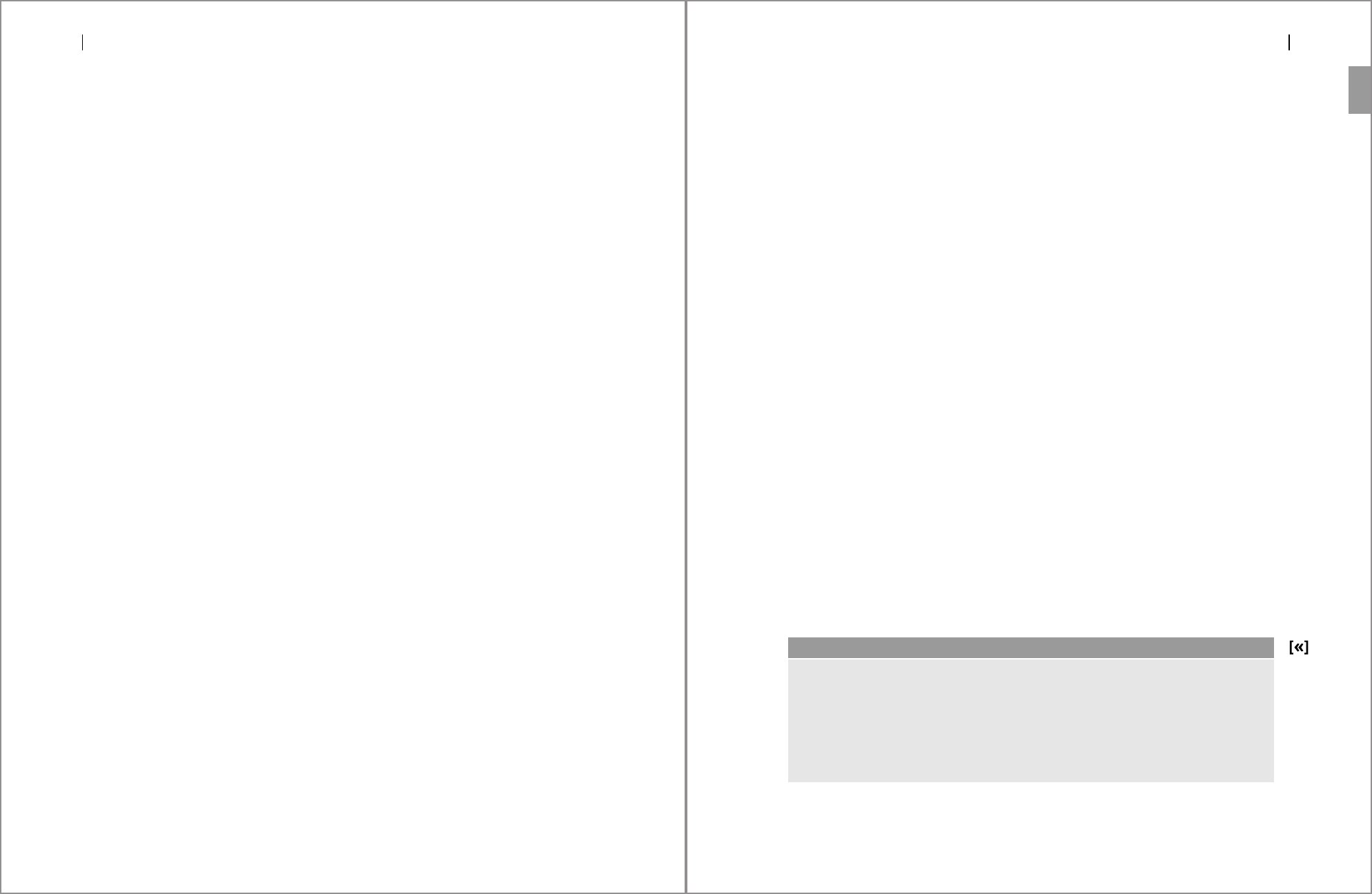
Architecture
2
50
In addition, the delivery processing includes interfaces for the integration of the
following components:
왘 Quality Inspection Engine (QIE)
왘 Post Processing Framework (PPF)
왘 Route Determination
왘 Global Trade Services (SAP GTS)
왘 Transportation Management (SAP TM)
In addition to the various interfaces and calling options of delivery objects, SAP
EWM also offers a number of BAdIs which allow you to carry out your own vali-
dations or, within the delivery processing, to fill customer-specific fields. In
Chapter 6, we give a complete overview of all BAdIs in SAP EWM. At various
BAdIs, SAP delivers sample implementations to give you a programming template
for orientation.
For further information, visit the SAP Service Marketplace (http://service.sap.com)
where you will find many SAP Notes with practical tips for troubleshooting and
coding examples (for example, 1064376, 1436107, 1462811, 1451135).
2.2 Warehouse Logistics
The warehouse logistics includes all movements of goods—both within the ware-
house complex as well as around the warehouse. SAP EWM supports numerous
processes such as the arrival of goods in the warehouse, goods receiving, and the
putaway process. It also supports internal storage processes, such as inventory,
quality control, supply, and reorganization.
The most important processes are picking and shipping. As the basis for almost all
logistics processes, warehouse logistics thereby serves the delivery request. It is
the pool and thus the request document for the warehouse on which planning
and reporting take place, as the warehouse request in SAP EWM serves the
delivery (see Section 2.1). On the delivery you can see the current processing
status and move in all dependent documents.
For Shipping & Receiving (S&R), complete deliveries, respective items, or handling
units (HU), are assigned to a transportation unit (TU). You can group TUs by vehi-
cles. The central document in SAP EWM is the warehouse task (WT) in which
Warehouse Logistics
2.2
51
activities within the warehouse are performed and documented. It serves the
movement of stock and/or HUs according to the data specified in the delivery
items. But it’s also possible to create and process them without a delivery refer-
ence for internal warehouse processes.
In addition to the WT, more processes can be carried out. For example, inbound
quality checks can be carried out (see Section 2.4). VAS can be integrated in the
inbound and outbound process. In the outbound process, the delivery items are
grouped in waves. WTs are created for a complete wave and bundled to ware-
house orders according to certain customizable criteria.
2.2.1 Shipping and Receiving
An incoming transport, such as a truck, often contains more than one delivery. To
illustrate this fact in the system, we can create in SAP EWM a separate object—the
TU—and assign deliveries, delivery items, or HUs to the TU activity.
When you create a TU, you will always produce an activity to the TU—the TU
itself is not editable. An activity (for TU, vehicle, or gate) is always valid for a spe-
cific time frame, which is defined in the activity. To a TU (it’s defined by the
external number + carrier), there may be several planned activities but only one
active activity; an activity is activated by the arrival at the checkpoint. Activities of
one or more TUs can be assigned to a vehicle.
The use of the object “vehicle” will only bring an added value when more than
one TU is used, for example, a truck with a trailer. If a delivery is distributed to
multiple TUs, this can be represented in the system by direct assignments of the
delivery items or HUs to these TUs. This takes place primarily in the goods issue
process during loading when the final deliveries are not yet known and process-
ing takes place on warehouse requests.
Yard Management in SAP EWM
The “yard” is the name we call the area outside of the warehouse complex, where the
arriving and departing TUs are handled. With yard management in SAP EWM, you can
not only register the incoming TUs at the gate but also assign locations and move them
within the yard. You can occupy parking spaces and create WTs for moving the TU to its
target (mainly a door). This provides an opportunity for parking management and
administration of additional TUs, for example, swap bodies or trailers that must be
moved with their own resources.
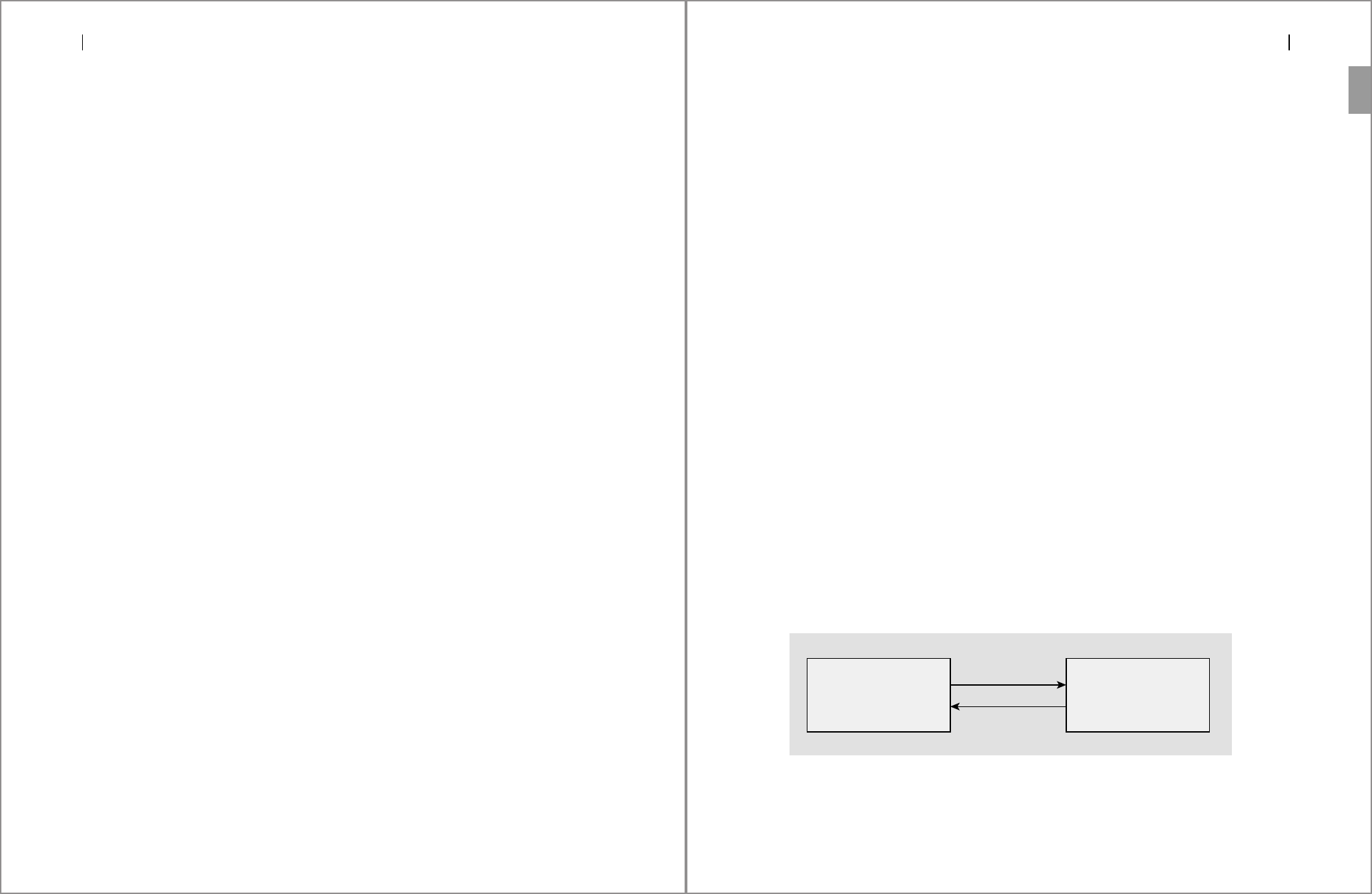
Architecture
2
52
The doors of the warehouse, where TUs are loaded and unloaded, must be
assigned to a storage bin in the warehouse. These door bins are necessary to cre-
ate WTs to the door. But it does not involve physically existing places where
goods are actually stored. Working with the yard management, the doors must
also be assigned to a storage place outside of the warehouse—the place where the
TU is off target. The two bins assigned to a door (outside and inside) connect the
yard to the warehouse complex.
The movement of a TU with a WT to a door automatically creates or activates a door
activity for the TU. Only one TU can be docked at a door. For this reason, we rec-
ommend the use of yard management for timely postings only. Without yard man-
agement, you must create and activate door activities manually in TU transaction.
S&R works on activating and deactivating with time stamps (current date and time).
The use of TUs also provides the ability to post the stock to the TU location. You
can therefore post goods receipts sooner without taking up storage space. Out-
bound process staging areas will not only be cleared from the goods issue but also
by loading the TU, thus you can manage staging areas better. Of course, loading
is possible without TUs; in this case, stock is moved to the door bin. The stock
transparency is thus no longer ensured, since physically the door bin does not
exist and stock cannot be checked. Accordingly, it is not clear where in fact the
goods are located.
The activity of a TU contains information about when the TU is expected in and
at what time it will leave the warehouse again. The activity may provide addi-
tional information, such as the driver and means of transport (e.g., license plate),
including other identifications and seal information. But above all, it includes sta-
tus information.
The activity of a TU is activated by the user action Arrival at Checkpoint. On
activated yard management, the HU of the TU is moved to the checkpoint bin.
From that point in time, the TU can be moved with WTs within the yard to a door
where it is unloaded or loaded. If no free door exists, it can be temporarily moved
to a parking lot.
Receiving
In inbound processing, customizing decides if the goods receipt (GR) is posted to
the TU location or door bin or to the staging area and thus if goods must be
Warehouse Logistics
2.2
53
unloaded or not. Customizing for GR posting can be found in the IMG on SCM
Extended Warehouse Management 폷 Cross-Process Settings 폷 Shipping and
Receiving 폷 General Settings 폷 Control of Goods Movements. If GR is posted
to a TU or door bin, unloading is required with WT. From goods receipt to stag-
ing area, no unloading is required, but it is supported with simple unloading.
After unloading the TU, it can leave the door and depart from the checkpoint or
it can be used for loading a shipping activity.
Status
Object TU and vehicle contain a number of statuses to document the current state
of the activity. For example: arrival at checkpoint, docked to door, begin loading, and
loading end. Existing both on the object “delivery” and on the object TU, status is
synchronized between the two objects. The TU informs the delivery upon arrival
at checkpoint about the status change, which sets the status in yard in the deliv-
ery. If the TU is already planned for a door, the door information is passed to the
delivery. If no open WT exists on the delivery item, it is written to the delivery.
Staging area determination is called to find an optimized staging area for the
door. When changing the TU, the synchronization between the TU and the deliv-
ery takes place directly. For this reason, the deliveries will be blocked and must
be changeable. Otherwise, the change is not possible for the TU.
Status changes on the delivery, as with changes in loading or goods movement
status, lead to a recalculation of the corresponding status in the TU activity.
Changes in quantity and repacking eventually lead to a change in capacitance of
the TU activity. Changes in delivery, such as status or quantity changes that affect
the transport, are not updated directly in the TU, but they result in scheduling a
PPF action that synchronizes the TU (see Figure 2.5).
Figure 2.5 Synchronization between Delivery and TUs
Transportation Unit Delivery
Synchron
Asynchron
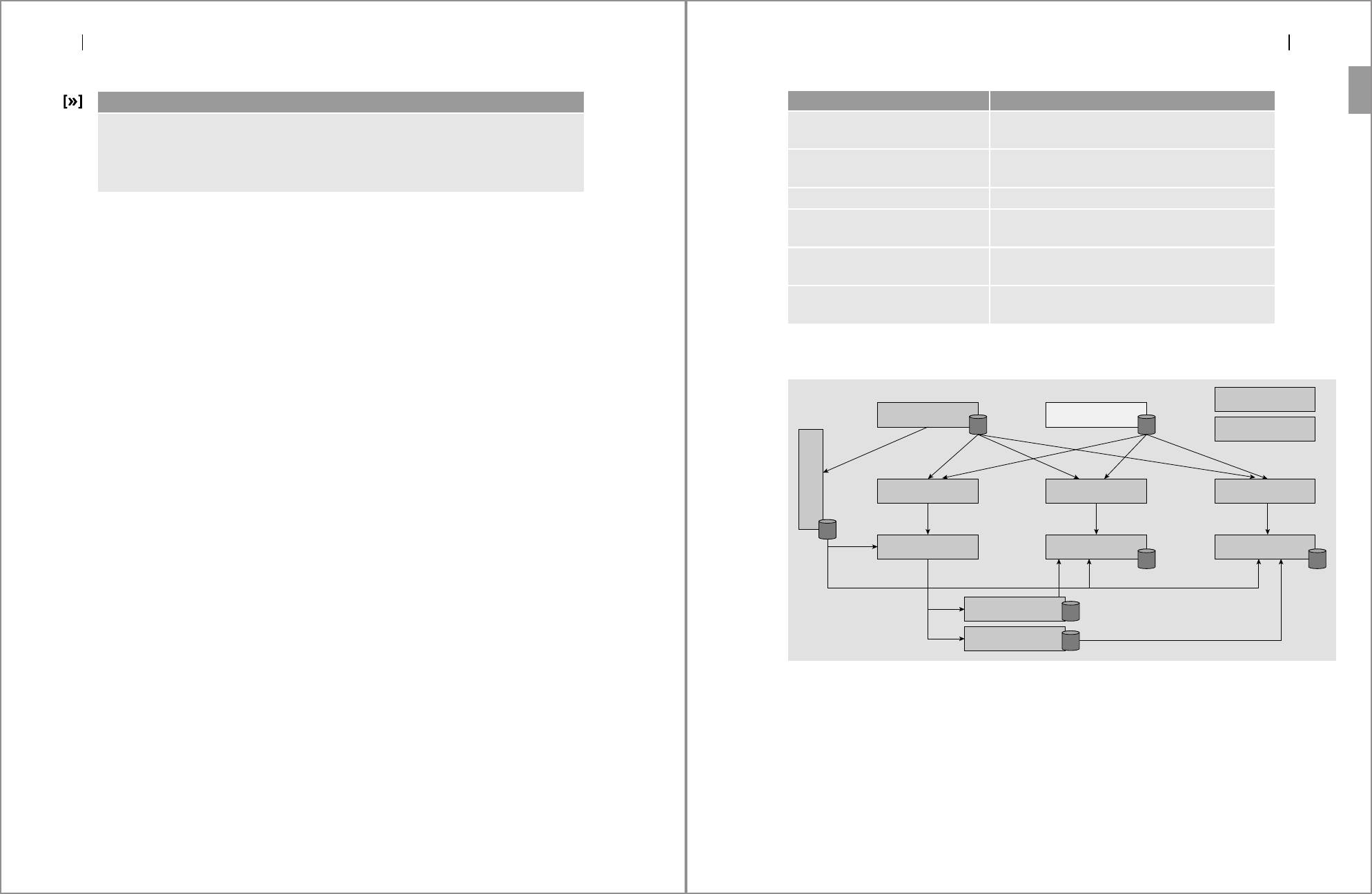
Architecture
2
54
Transport Units Contain Only References
TUs do not contain their own quantity, product, or HU information; only references to
the delivery number, respective item, and possibly to HUs.
For this reason, the UI of the TU always shows the current state of the HU data. These
data do not necessarily correspond with the data of the received HUs after unloading.
Shipping
For shipping, a TU activity can arrive at a checkpoint that only picks up goods or
a TU can be reused that previously delivered incoming goods and is still active in
the yard or at the door. For such a TU, the shipping activity can be activated and
the system automatically closes the incoming activity. If the incoming activity is
located at a door, create and activate a door activity for the outgoing activity also.
With active yard management, the location of the TU does not change.
Since the transported objects need not be planned, they can be assigned by load-
ing spontaneously; as opposed to inbound, it is not automatically determined by
the system when the loading is complete. Status Loading Completed must
always be set manually; if loading started, completion is a prerequisite before the
activity can leave the checkpoint again.
WTs are necessary for the unplanned loading of TUs, which provide the assign-
ment of HUs to TU.
Data Model
S&R is part of the namespace /SCWM/. The responsibility is summarized in the
component SCM EWM-SR and its subcomponents. Beside the object’s TU, vehi-
cle, and door, this component also handles staging and door determination, as
well as loading and unloading functionality. Both functions are relevant for deliv-
ery processing, regardless of the use of TU.
The package
/SCWM/SHP_RCV is divided into five subpackages. In addition, package
/SCWM/YARD_MGMT is valid for yard management functionality. Table 2.4 lists the
packages that are relevant for S&R.
The processing of transactional data is done via the classes shown in Figure 2.6.
Warehouse Logistics
2.2
55
Figure 2.6 Class Model of S&R
Each activity will be managed by a separate instance of that particular class. The
data can be found in the classes
/SCWM/CL_SR_DO.. The business logic is executed
through the associated classes
/SCWM/CL_SR_BO.., which hold a reference to the
current instance of data. The property manager
/SCWM/CL_SR_BOM manages the
instances of business objects
/SCWM/CL_SR_BO.., etc.
Package Function
/SCWM/SHP_RCV_CORE Processing of TU, vehicle, door, and staging area
determination
/SCWM/SHP_RCV_CUST Customizing tables, maintenance views, functions
for reading customizing and F4-help
/SCWM/SHP_RCV_PPF Implementing PPF
/SCWM/SHP_RCV_UI Transactions for processing of TU, vehicle, and
door activities
/SCWM/ERP_TM_INTEGRATION Customizing and IDocs for integration of SAP ERP
shipment (LE-TRA)
/SCWM/YARD_MGMT Definition of checkpoints, transaction for check-in
and checkout, yard moves
Table 2.4 Packages for S&R
/SCWM/CL_SR_TM/SCWM/CL_SR_BOM
/SCWM/CL_SR_TUDLV
/SCWM/CL_SR_BO_TU /SCWM/CL_SR_VEH /SCWM/CL_SR_BO_DOOR
/SCWM/CL_SR_DLV
/SCWM/CL_SR_DO_TU /SCWM/CL_SR_DO_VEH /SCWM/CL_SR_DO_DOOR
/SCWM/CL_SR_DO_TU_VEH
/SCWM/CL_SR_DO_TU_DOOR
/SCWM/CL_SR_DO_MANAGER
TU TU
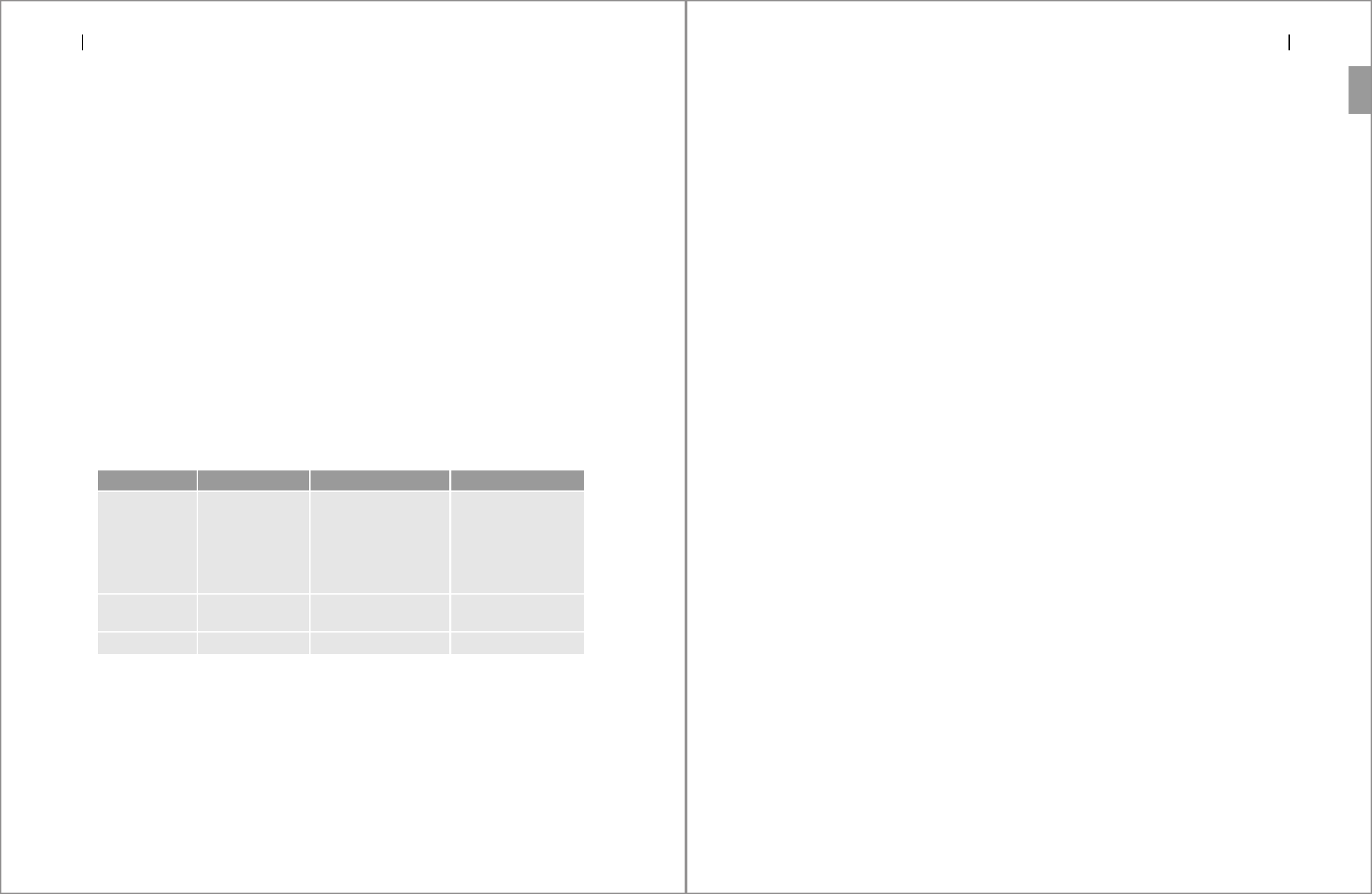
Architecture
2
56
The links between TU and vehicle or gate are managed in their own classes,
which are referenced in the class
/SCWM/CL_SR_DO_TU. For performance reasons,
keep the corresponding instances of door and vehicle keys with a table of the
associated TUs.
The link between TUs and delivery is managed in class
/SCWM/CL_SR_TUDLV. It is
independent of the other classes and may also be used without them if no other
information about the TU or vehicle is required. Class
/SCWM/CL_SR_DLV is the
interface of the TU for the delivery. It informs the delivery about changes in its
assignment and status.
The class
/SCWM/CL_SR_DO_MANAGER exists only for historical reasons and must not
be used directly. Only the methods for reading/setup of all relevant objects will
remain and must only be used by the business object manager class
/SCWM/CL_
SR_BOM
.
The three objects in S&R consist of the object header and any number of activities
in this header. For an entry in table
/SCWM/TUNIT or /SCWM/VEHICLE at least one
entry in its activity table
/SCWM/TU_SR_ACT respective to /SCWM/VEH_SR_ACT must
exist. All additional tables contain entries relevant to the activity. The tables of
the objects are listed in Table 2.5.
TU and vehicle header are deleted if the last activity is deleted.
The object “door” has a special status because it is defined in customizing. Entry
must exist when creating an activity, and door activities cannot be created as
Object Table Activity Additional tab
Transport Unit /SCWM/TUNIT /SCWM/TU_SR_ACT /SCWM/TU_STATUS
/SCWM/TU_IDENT
/SCWM/TUNIT_SEAL
/SCWM/TU_VEH
/SCWM/TU_DOOR
/SCWM/TU_DLV
Vehicle /SCWM/VEHICLE /SCWM/VEH_SR_ACT /SCWM/VEH_STATUS
/SCWM/VEH_IDENT
Door /SCWM/TDOOR /SCWM/DOOR_SR_ACT
Table 2.5 Tables of Objects in S&R
Warehouse Logistics
2.2
57
standalone. They only exist with a reference to a TU activity. This means for any
entry in
/SCWM/DOOR_SRACT an entry in /SCWM/TU_DOOR must exist.
For just about any action that can be performed for an activity, the BAdI
/SCWM/EX_SR_ACTION_TU for TUs, /SCWM/EX_SR_ACTION_VEH for vehicles, and
/SCWM/EX_SR_ACTION_DOOR for doors is called. Those BAdIs can be used for cus-
tom checks and trap implementation.
Since the three objects are independent and some changes have an impact on
more than one object, the consistency of the objects must be ensured when the
data changes. For this reason, if any method of
/SCWM/CL_SR_BO_.. class (briefly:
BO method) is performed, a copy of instance
/SCWM/CL_SR_DO.. (briefly: DO) is
saved before the first data change. In addition, they inform the class
/SCWM/CL_
SR_TM
that it has produced such a copy.
If an action is successful, the application that called the action—such as “upon
arrival at the checkpoint”—calls class
/SCWM/CL_SR_TM to initialize and inform all
stored BO instances to delete the copy.
If within an action in one of the objects an error is raised, class
/SCWM/CL_SR_TM is
also called. It will inform all stored BO instances to discard the current DO refer-
ence and replace it with the copied one. Furthermore, it is ensured that if an error
occurs, data will be the same on all objects like before the action started.
2.2.2 Warehouse Task and Warehouse Order
Goods movements within the warehouse are mapped on the object WT. For
goods movements, such as goods receipt, goods issues, and posting changes, the
system generates completed WTs without a warehouse order for documentation.
Rearrangements within the warehouse consist of scheduled and completed WTs.
When creating a scheduled task, a warehouse order is automatically generated in
accordance with the warehouse order creation rules defined in customizing. The
warehouse order can be assigned to a resource group and is used to edit and con-
firm assigned WTs.
The purpose of a WT can be identified by its warehouse process category (
TRART).
The possible modes of transport are listed in Table 2.3. The data available on the
WT depends on this process category. See Table 2.9.
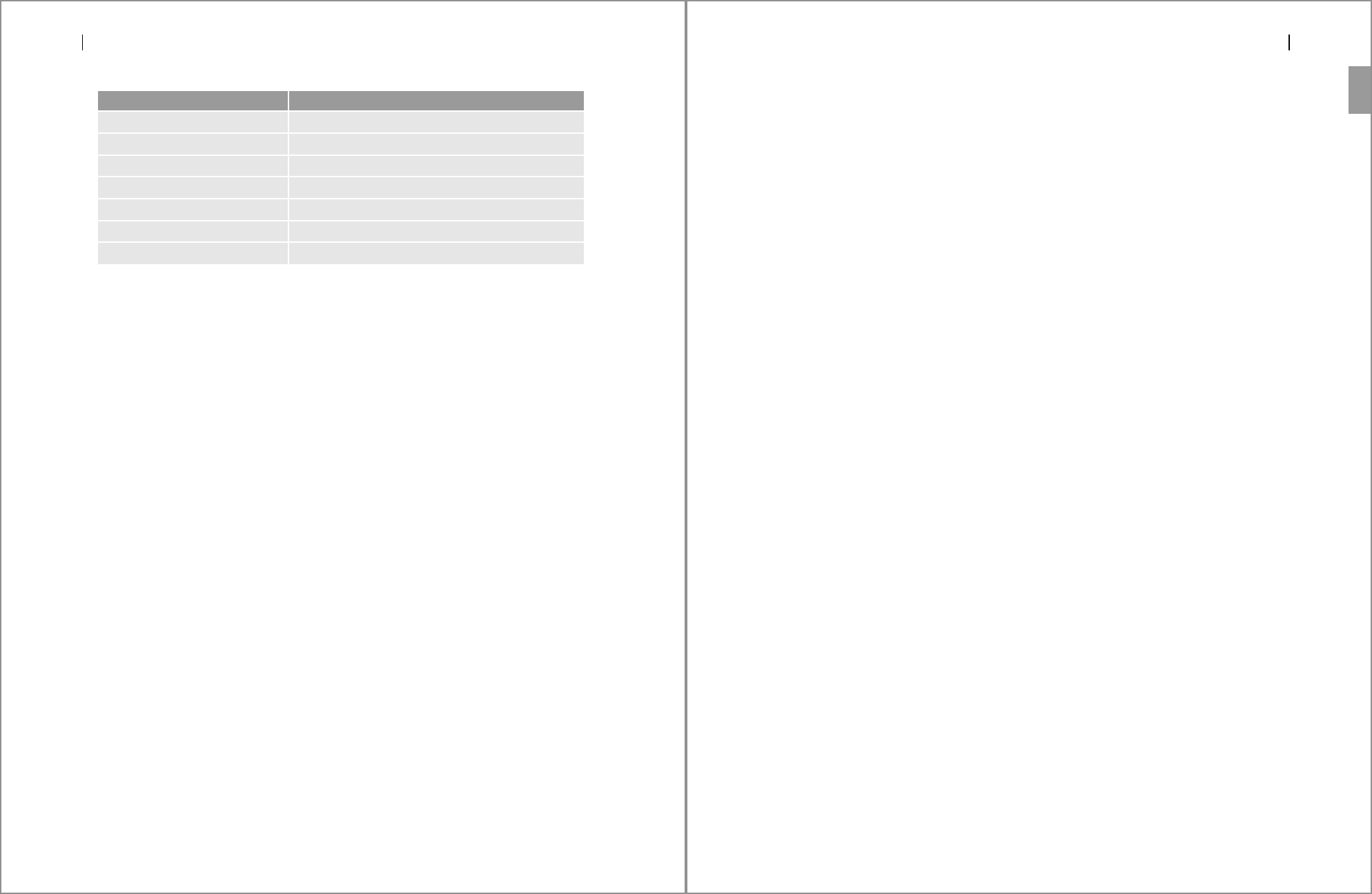
Architecture
2
58
Storage and retrieval can be done in several steps. This can be due to the process
(in this case, the process will be guided by process-oriented storage control) or
warehouse layout (which is defined by layout-oriented storage control). The var-
ious storage process steps of the process-oriented storage control are usually
optional and some are feasible at any point in the process. Most can be defined as
rule-based, which means they can be included in the process profile, but they are
carried out only on the existence of a dependent document.
These steps are divided in two stages and must be completed manually after the
transfer, while single-stage process steps are completed automatically with the
confirmation of the WT. At each process step, the system determines whether the
completion of the process step leads automatically to create the WT of the next
step or whether this takes place at a later date. To use the process-oriented storage
control it is necessary to work with HUs, which serve as carriers of the storage
control information.
In the following section, data determination for storage and retrieval is discussed
in more detail.
Warehouse Process Category 1 (Putaway)
The putaway storage process consists of HU and product WTs. The final putaway
can be done with both types of WTs. So it’s also possible to putaway mixed HUs.
Product WTs always contain an inbound delivery reference, whereas HU WTs
only refer to a document if it is unique.
If WTs are created prior to GR, the source location is determined from first deliv-
ery item within the tasks (HU). After GR, the source location is determined by the
Warehouse process category Description
1 Putaway
2 Picking
3 Internal movement
4 Inventory
5 Goods receipt
6 Goods issue
7 Posting change
Table 2.6 Warehouse Process Categories in SAP EWM
Warehouse Logistics
2.2
59
location of HU or stock that should be moved. Destination data comes from stor-
age process or putaway strategy (for final putaway task).
In the goods receipt process, the last step is always the final storage. However, the
WTs for this process step can be created at any time during storage process. This
is done on the identification PRODUCT / HU WT in the allocation form of the
storage process to a storage process. In this case, the WTs are created with the sta-
tus WAITING and assigned to a warehouse order. In the next section, a multistage
goods receipt process is described, and the roles of the objects “WT” and “HU”
will be explained.
1.
Move transport unit to door
Upon arrival of a transport unit, these can be moved with active yard manage-
ment using WTs in the yard. This WTs move a HU named by the TU. As a
source location, the actual location of the TU HU is determined. Either obtain
the destination from the storage process type or enter it manually. Confirma-
tion of this WT will dock the TU to a door. If no yard management is used, then
process the door docking manually.
2.
Unloading
If the goods receipt of a delivery item is received in the staging area, unloading
is not mandatory, but it can be done by so-called simple unloading. In the deliv-
ery, a document flow is generated by the unloaded amount and UNLOADED
status set for the HUs.
If the goods receipt of the delivery item is posted to the TU or a door bin, HUs
or unpacked stock must be unloaded with WTs. Unloading is an integral part of
the goods receipt process. Concerning unloading, there are basically the follow-
ing two options:
왘
Unloading without storage process
For unpacked goods, the system creates a WT with the storage process type
of the delivery item. In this case, the WT represents unloading and putaway.
This is also possible for HUs when creating the putaway WT. Confirmation
of the unloading will also confirm the putaway step if no manual interaction
with change of destination is performed. From the unloading UI, it’s also
possible to unload the HU to the staging bin of the delivery item.
왘
Unloading with storage process
The first warehouse process step of the storage control in the HU must be the
unloading step. If WT creation is called for, this HU, the system automatically
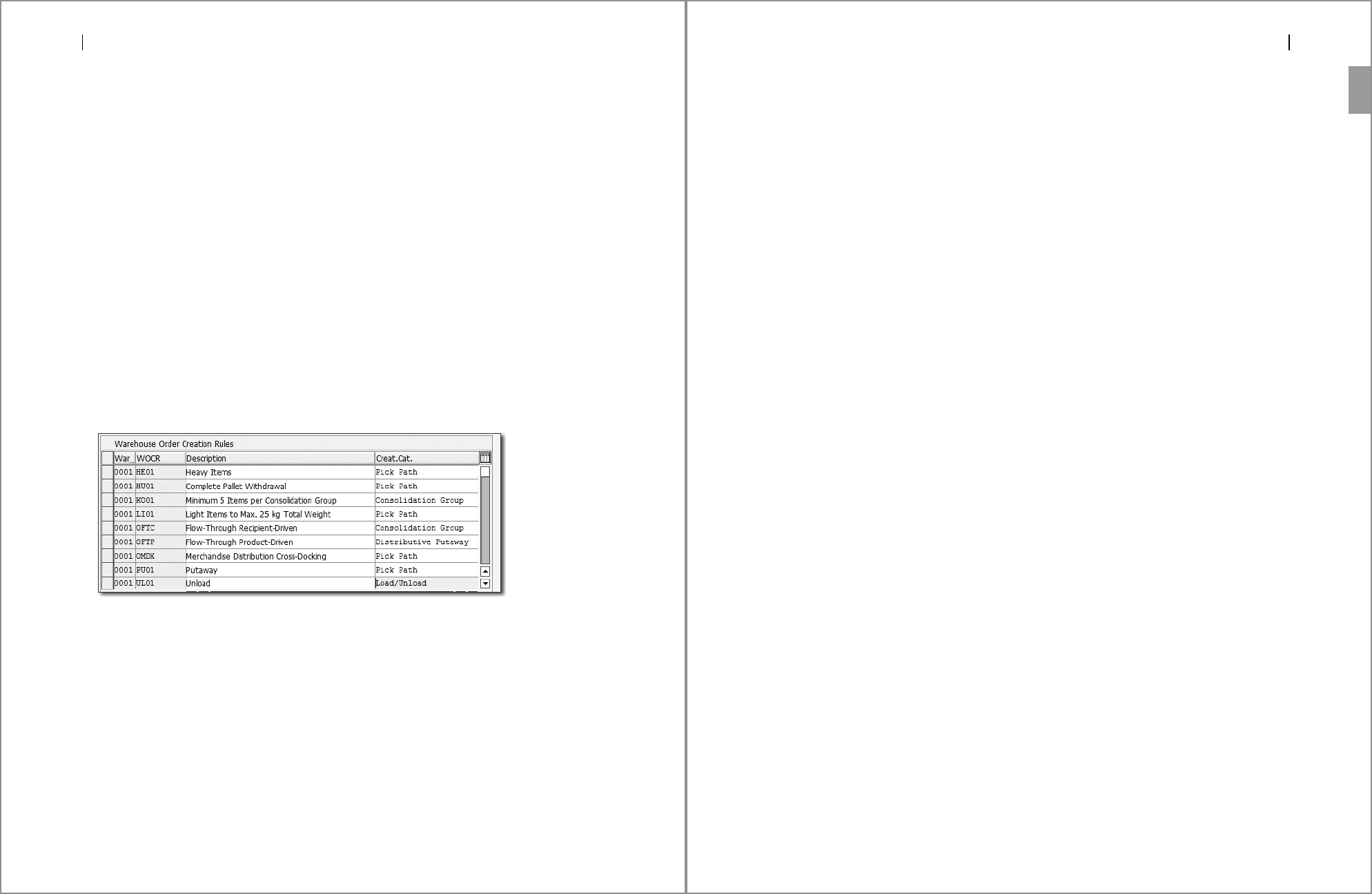
Architecture
2
60
creates a HU WT from the delivery item GR location to the staging area of the
inbound delivery.
For unloading, WTs using a warehouse order creation rule of the type
load/unload makes sense. You can create it by choosing the IMG path
Extended Warehouse Management 폷 Cross Process Settings 폷 Ware-
house Order 폷 Define Warehouse Order Creation Rule. Use the creation
type load/unload for the corresponding warehouse order creation rule
(Figure 2.7). If the unloading WTs are created automatically by the system
from PPF or manually for a complete delivery or TU, all WTs are created in
parallel. In this case, all WTs are assigned to one warehouse order. Depend-
ing on the number of workers configured, additional warehouse orders
without WTs are created to allow parallel unloading in Radio Frequency
(RF). Confirmation of an unloading WT will reassign the WT from the main
warehouse order to the warehouse order of the worker. This means that
multiple users can process the same worklist without a predefined unloading
sequence. In the end, the identity of the user who unloaded the single HU is
documented.
Figure 2.7 Warehouse Order Creation Category within Warehouse Order Creation Rule
3. Counting
Counting may be included as a rule-based step in the storage controller. If an
HU item is relevant for counting by an existing counting document for the
packed delivery item, an HU WT is created to a counting station. There the con-
tent of the HU is counted and the step is then completed. If the counting step
is not identified as rule-based, the HU is brought to the counting station regard-
less of the existence of a counting document.
Warehouse Logistics
2.2
61
For delivery items with a counting and quality step or a VAS, the counting step
must be included in the storage control prior to those steps. For storage pro-
cesses that contain only deconsolidation and putaway after unloading, count-
ing may be completed implicitly by those WTs.
4.
Quality inspection
The quality control may be included as another rule-based step in the storage
process. If a quality inspection document exists for the content of the HU, a WT
is created for the inspection bin determined by the inspection document
(inspection rule). However, the HU is only moved to the quality work center of
the first relevant quality inspection. If the HU contains several test-relevant
items with different quality work centers, the routing between them must be
done manually. If no work center can be determined, no HU WT is created and
the step must be completed at the current bin.
After completion of the quality inspection, the HU must be marked Com-
pleted. The system does not check whether there is still noninspected stock in
the HU.
5.
Value-Added Service
The storage process step for VAS should be defined as rule-based also. This step
is relevant if at least one item of the HU contains a VAS order. A HU WT is cre-
ated to a work center for VAS. After completion of the VAS, the user must mark
the HU as Completed.
Although the VAS step can be implemented at any point in the storage process,
processing a product after a possible quality inspection makes more sense.
6.
Deconsolidation
Deconsolidation is an optional step in storage control that may be marked as
rule-based. To use deconsolidation step it’s mandatory to create putaway WT in
an earlier defined process step. Those putaway WT are then created with status
Waiting.
An HU is relevant for deconsolidation if there is more than one WT for the con-
tent of the HU with a different consolidation group. Content of the HU has to
be repacked so that the resulting HU can be used for putaway. The deconsoli-
dation step must also be Completed manually.
7.
Putaway
Putaway is always the last step in the goods receipt process. You can create the
WT for this step at any time in the process. In the putaway step, you create a put-
away WT or activate an already existing putaway WT with the status Waiting.
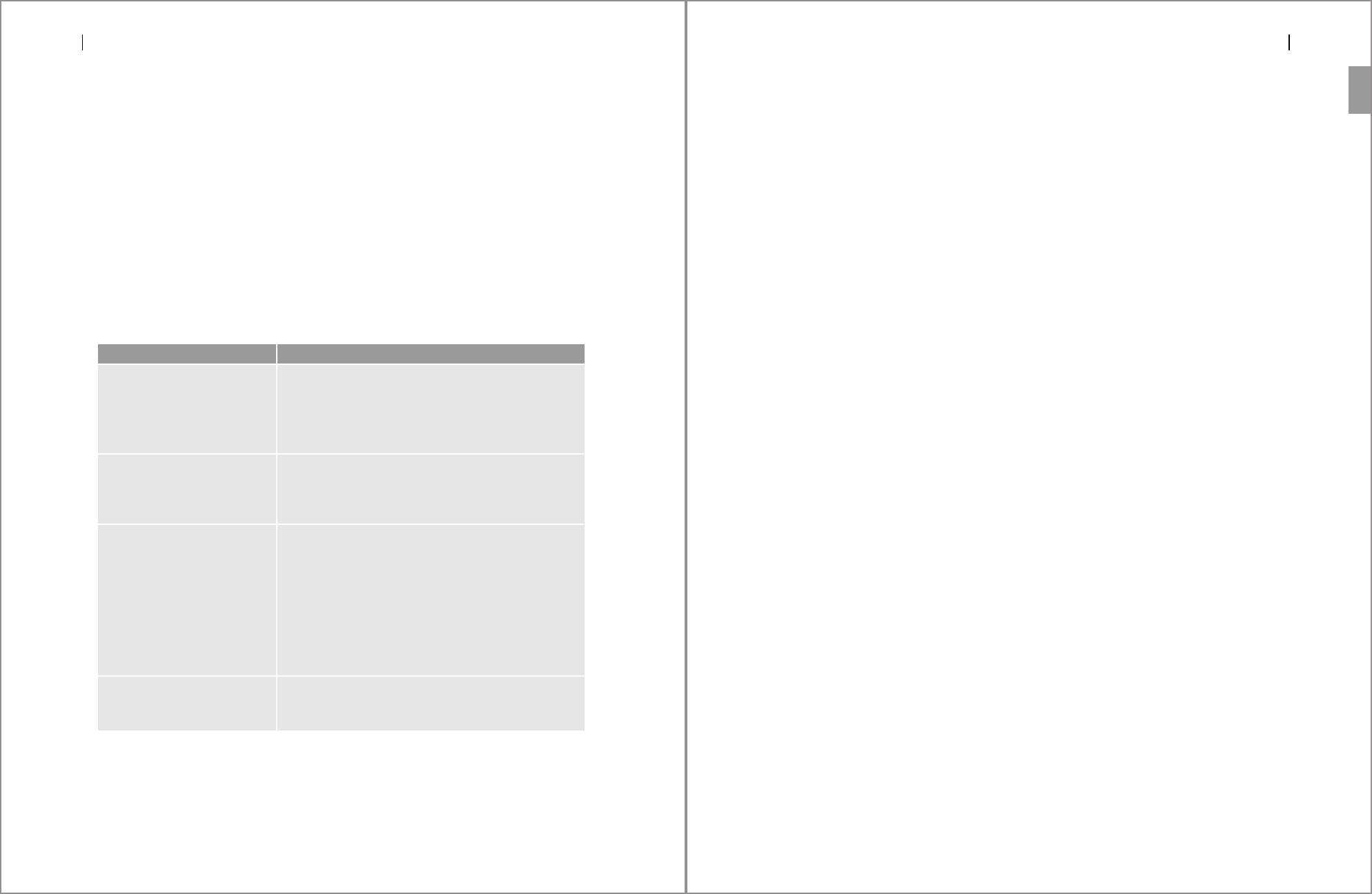
Architecture
2
62
Warehouse Process Category 2 (Picking)
The outbound process always starts with a product WT with reference to the out-
bound delivery order, which is called picking. For this product WT, source stock
determination is done by warehouse process type (WPT) from the delivery item
and picking strategy. Destination data comes from outbound delivery order.
Upon creation of picking WTs, they are bundled to warehouse orders with ware-
house order creation rules. In picking, the warehouse order creation provides the
most opportunities for optimization and processing of different scenarios (see
Table 2.7). For this reason, it makes sense to create as many WTs as possible
together. For this, SAP EWM offers the wave functionality: with waves, delivery
order items that are to be picked in a certain period are pooled, and with the
wave release, the WTs for all items within this pool are created.
Creation Category Description
Consolidation group If possible, all WTs for one consolidation group are
picked together. So all products going to the same cus-
tomer are held (packed) together at an early stage.
The picking path is a bit longer, but you can possibly
skip an additional repacking.
Pick path WTs are sorted by pick path and then bundled so that
the shortest paths are covered, and the pickers are
working in different areas. But products have to be
brought to a packing station to consolidate deliveries.
Pick pack pass – system The WTs are bundled according to the consolidation
group within an activity area. The order of the ware-
house orders of a consolidation group is defined in
customizing, and only one warehouse order is active.
Others are waiting. Confirming a warehouse order
activates the next warehouse order of the same conso-
lidation group in the next activity area. For this
scenario, several activity areas must be assigned to
the activity area for warehouse order creation.
Pick pack pass – user In this scenario, the WTs are also bundled on consoli-
dation group per activity area, but all warehouse orders
are active.
Table 2.7 Warehouse Order Creation Categories for Picking
Warehouse Logistics
2.2
63
Process-Oriented Storage Control in Outbound Processing
In this section, a multistage outbound process is described, and the roles of
objects WT and HU are explained. The five stages, in order, are:
1.
Picking
WT creation for picking is completed like the outbound delivery order item
and picking strategies described earlier.
2.
Value-added services
The storage process step for VAS should be maintained as rule-based within the
storage process. In this case, the step is only relevant if a VAS document exists
for the outbound delivery order item. If VAS is the second step within the stor-
age process, picking WTs are already created to the VAS work center. On con-
firmation of picking WTs, picking HUs must be used. If VAS is not the second
step within the storage process, an additional HU WT is created to the VAS
work center.
3.
Packing
If WTs are bundled by pick path, different pickers pick stock for one delivery.
For shipping, those stock must be consolidated and packed at a packing work
center. In this case, picking WTs are created directly to the packing work cen-
ter. With the VAS step, the HUs are moved from the VAS work center to the
pack station with HU WT if needed. The packing step in the storage process
must be completed manually.
4.
Staging
In the staging step, the HUs are moved to the staging area.
5.
Loading
Loading creates HU WTs from the staging area to the door of the outbound
delivery order item. Confirmation of any WT to a door bin is defined as loading
WT and creates a document flow entry in the delivery order items and a status
on the HU in case of a HU move. If a TU is docked to the door when confirming
the WT in RF, destination of the WT is changed directly to the TU.
Data Model
The processing of WTs can be found in package
/SCWM/CORE. Warehouse order
creation is assigned to package
/SCWM/WHO.
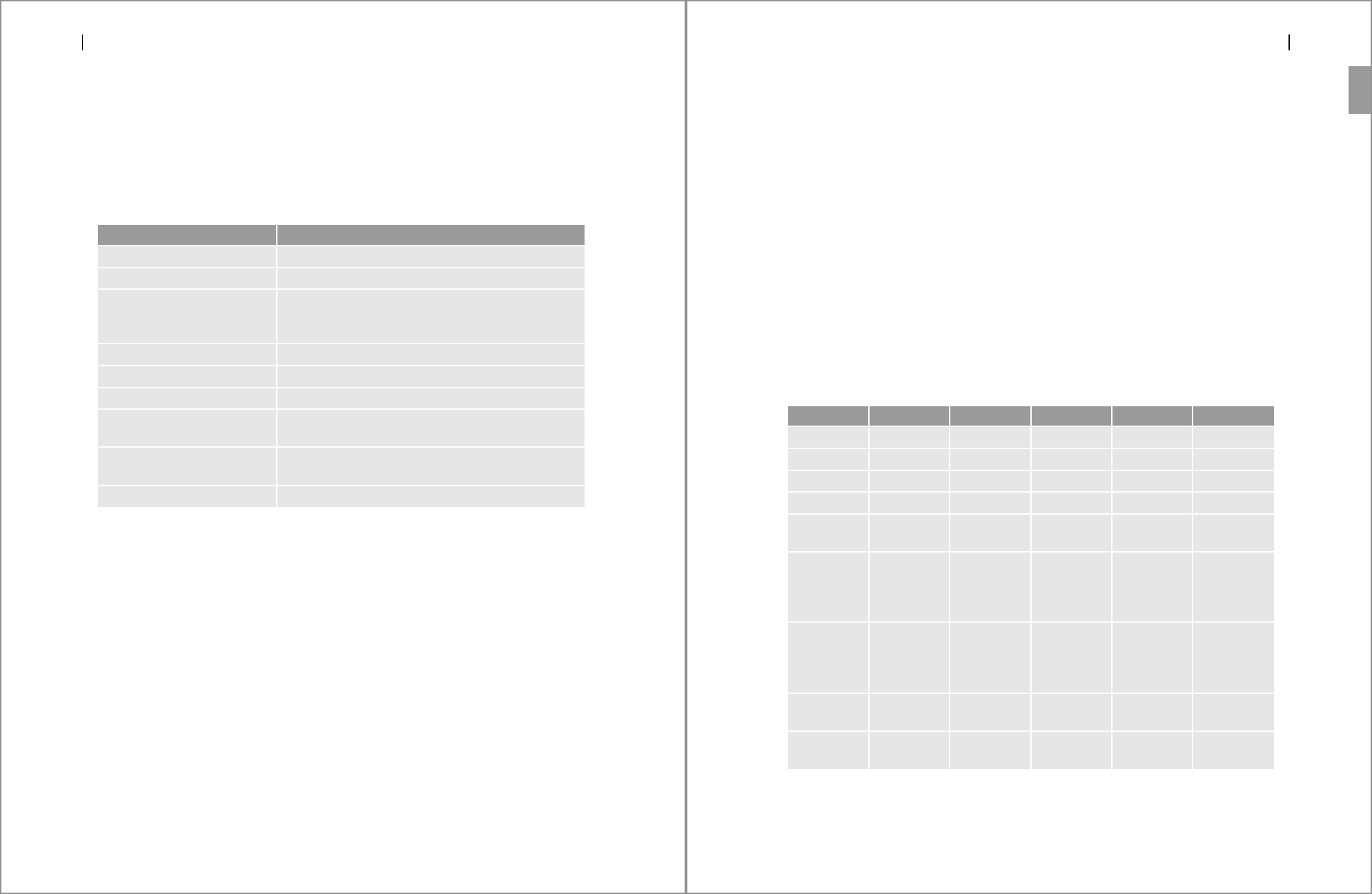
Architecture
2
64
Planned WTs are stored in table /SCWM/ORDIM_O with an identical entry in /SCWM/
ORDIM_L
. On confirming or canceling this planned WT, the entry in /SCWM/ORDIM_O
is deleted and a new entry is created in table /SCWM/ORDIM_C. This ensures that the
table of open WTs is kept small and accesses accordingly perform well. WTs
always references a warehouse order in table
/SCWM/WHO.
Table 2.8 lists the tables in which the data for WT processing is stored.
The amount to be moved with a WT can be confirmed partially. This is called
splitting the WT. It creates a confirmed WT entry with the confirmed partial
quantity. This is, for example, necessary if the amount is divided between more
than one destination (pick) HU or if the source HU is a nested HU and picking is
done from part of a sub-HU or from some complete sub-HUs. The table key of
/SCWM/ORDIM_O and /SCWM/ORDIM_L is the warehouse number and WT. Tables of
confirmed WTs contain an additional item number.
The attributes of the WT can be divided in the following groups:
왘 Organizational data: user name, creation date, resource, queue, confirmation
date, etc.
왘 Stock attributes: product, quantity, batch, stock category, etc.
Table Usage
/SCWM/ORDIM_O Planned WTs with status open or waiting
/SCWM/ORDIM_OS Serial number for open WTs
/SCWM/ORDIM_L Log-table for planned WTs. It’s a copy of the original
entry in
/SCWM/ORDIM_O which documents the initial
values. It is not updated at any point in time
/SCWM/ORDIM_LS Serial numbers for log-table
/SCWM/ORDIM_C Completed WTs
/SCWM/ORDIM_CS Serial numbers for completed WTs
/SCWM/ORDIM_H Stock information for confirmed HU WTs with mixed
stock
/SCWM/ORDIM_HS Serial numbers on mixed HU WT referencing /SCMW/
ORDIM_H
/SCWM/ORDIM_E Exception codes for completed WTs
Table 2.8 Tables of WTs
Warehouse Logistics
2.2
65
왘 Source location: description of the location in the warehouse where stock is
currently placed. Source storage bin, source HU, sources resource, or source
TU.
왘 Destination location: description of the location in the warehouse where the
stock must be put. Destination storage bin, destination HU, destination
resource, or destination TU.
왘 Additional data: more general attributes, such as
FLGHUTO, which indicates the
move of the complete source HU, or field
HOMVE, which signifies for the product
WTs that the complete stock of source HU should be moved and if the move of
complete HU is possible.
Organizational data attributes are always filled. Stock attributes are only filled for
product moves, stock changes, and HU moves with unique stock. Source and des-
tination data depend on the type of WT. What data is filled on which posting
(transportation type and product or HU posting) can be found in Table 2.9. The
transport types shown are defined in table
/SCWM/T333A.
Type TRART Source Destination Stock Additional
Product GR 5 X X
HU GR 5 X Optional FLGHUTO
Product GI 6 X X
HU GI 6 X Optional FLGHUTO
Posting
change
7 X
X
X
X
Product put-
away, pick-
ing, internal
move
1, 2, 3 X X X HOMVE
HUENT
HU put-
away, pick-
ing, internal
move
1, 2, 3 X X Optional FLGHUTO
MOVEHU
Inventory of
complete HU
4 X X Optional FLGHUTO
Product
inventory
4 X
X
X
X
Table 2.9 Provided Data within WT Depending on Type of Task
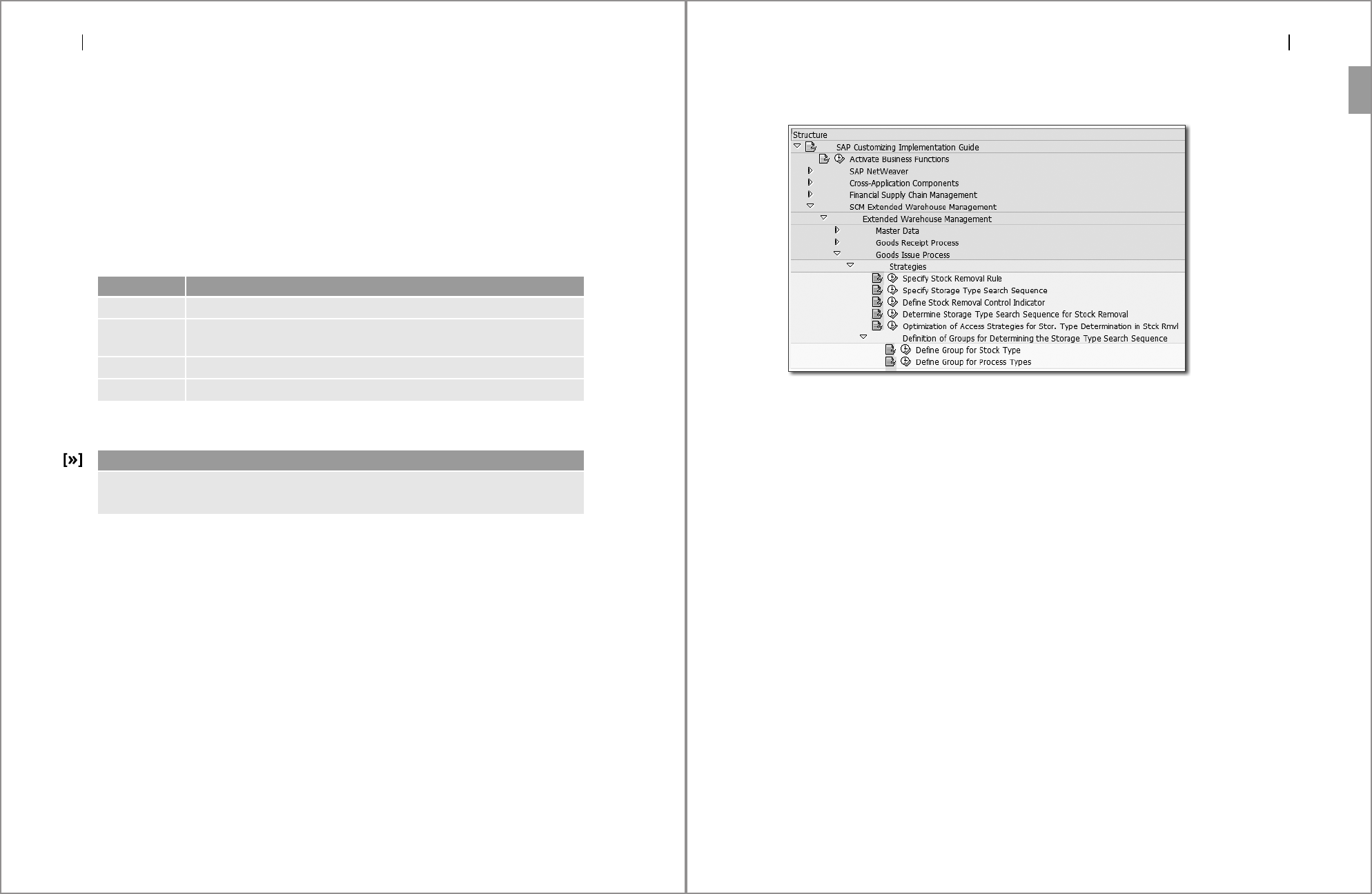
Architecture
2
66
From and to data include the location and the HU. Besides the location, the
affected
GUID_HU is always filled. HU identification remains for the initial dummy
HUs, which makes it easy to see whether this is a real or a virtual HU. Flag
FLGHUTO indicates whether the task was created as an HU posting. If destination
storage type does not allow real HUs, only the content of the HU is moved, which
can be identified on flag
MOVEHU. If a product WT for a complete HU is created, it
is identified by flag
HOMVE. In this case, the complete HU can be moved like a
HU WT and flag
HUENT is set to indicate the HU move.
WTs can have different statuses (see Table 2.10).
Planned Warehouse Tasks are Never Deleted
Planned WTs can only be canceled but not deleted. Confirmed WTs and stock postings
cannot be canceled. They must be posted in the opposite direction with a new WT.
Source-Data-Determination
For putaway WTs for inbound delivery items without GR, the source bin is deter-
mined from the inbound delivery item’s GR location. After GR, the source loca-
tion is taken from stock with reference to this inbound delivery item. For manual
product WTs (Transaction /SCWM/ADPROD) or HU WTs (Transaction /SCWM/
ADHU), stock must be selected by the user to be able to create a WT.
For pick WTs, source data is determined by available quantities (table
/SCWM/
AQUA
) with picking strategy and packaging specification for the product. An excep-
tion to this rule is the WT creation for a cross-dock scenario. In this case, the
outbound delivery order already contains information about the inbound deli-
very and WT searches for inbound delivery stock reference (where putaway has
not been completed). Source location determination is done in function group
/SCWM/REM_BIN_DET.
Status Usage
Open WT waiting for processing
Waiting WT that reserves source stock and capacity on destination but cannot be
processed
Confirmed WT was processed successfully
Canceled Planning was canceled
Table 2.10 Status of a WT
Warehouse Logistics
2.2
67
Figure 2.8 shows the customizing of the picking strategy.
Figure 2.8 Customizing for Picking Strategies
The picking strategy defined in customizing is used to determine the source stor-
age bin respective source HU. If a quantity classification is defined in source stor-
age type, the system calls packaging specification determination with type 0WHT
and determines the relevant level for operations with the quantity classification
of the storage type. Upon successful level determination, the operational unit of
measure is set by the packspec level. An optional rounding of the WT quantity
can be done (e.g., to ensure that only whole boxes are picked), or the quantity can
be reduced to one unit of the operating unit (e.g., in a bulk storage where one WT
must be created per pallet).
With the BAdIs listed in Figure 2.9, picking strategy and thus affected source loca-
tion determination can be customized specific to the process. For example, the
operational unit of measure (UOM) can be set if stock is stored in a different UOM
than in the standard storage type. An example of implementation can be found in
Section 4.
To allow parallel WT creation, the source storage bin is locked with a shared
enqueue. This allows any number of parallel processes to access this data. An
exclusive lock is used for the quantity of the created WT to ensure availability.
For product WTs with a given source HU, the HU also receives a shared lock. This
is also true for repacking at a work center. When moving a complete HU or
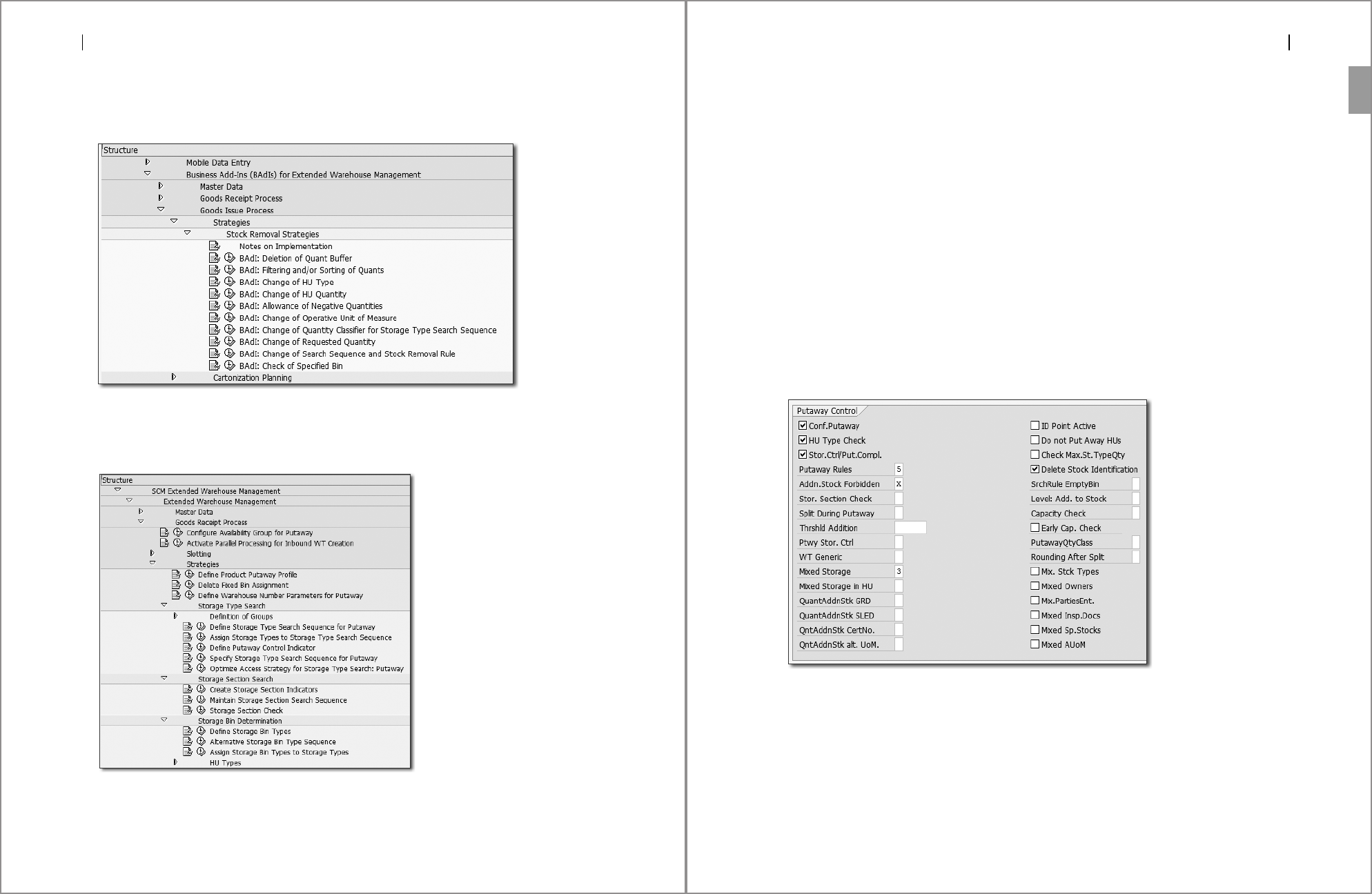
Architecture
2
68
repacking a complete HU, the HU is gets an exclusive enqueue. Therefore repack-
ing stock must be saved prior to repacking or moving the HU.
Figure 2.9 Business Add-Ins to Influence Picking Strategy and Source Location Determination
Destination Data Determination
Figure 2.10 Customizing of Putaway Stategy
Warehouse Logistics
2.2
69
Destination data for final putaway is determined by the putaway strategy defined
by the product. The definition of putaway strategy is completed in the customiz-
ing of the goods receipt process (see Figure 2.10). For other processes, destination
data is taken from the delivery item or storage process step (e.g., work center), or
is defined manually.
Examination of destination data is done in function group
/SCWM/PUT_BIN_DET.
Here, according to the settings on the storage type (see Figure 2.11), the mixed
storage and capacity check is called. On moving a complete HU (HU WT or prod-
uct WT for complete HU quantity), the capacity of the HU header is used for
capacity check. Mix stock and capacity check are done in function group
/SCWM/
HUFUNC
. Function module /SCWM/TO_HU_INT is called. The destination HU (as long
as it’s no dummy (see Section 2.3.2)) is locked exclusively by an enqueue. Desti-
nation bins are also locked if mix stock and capacity check must be done. Deacti-
vation of capacity check and capacity update can be useful for work center and
staging bins.
Figure 2.11 Setup for Mixed Storage and Capacity Check within Storage Type
Pure product WTs determine a packaging specification with condition type
0WHT. Capacity information is determined up to the relevant level in the packag-
ing specification, which is defined by the quantity classification for putaway (gen-
eral quantity classification if no specific is defined). Only HU relevant levels are
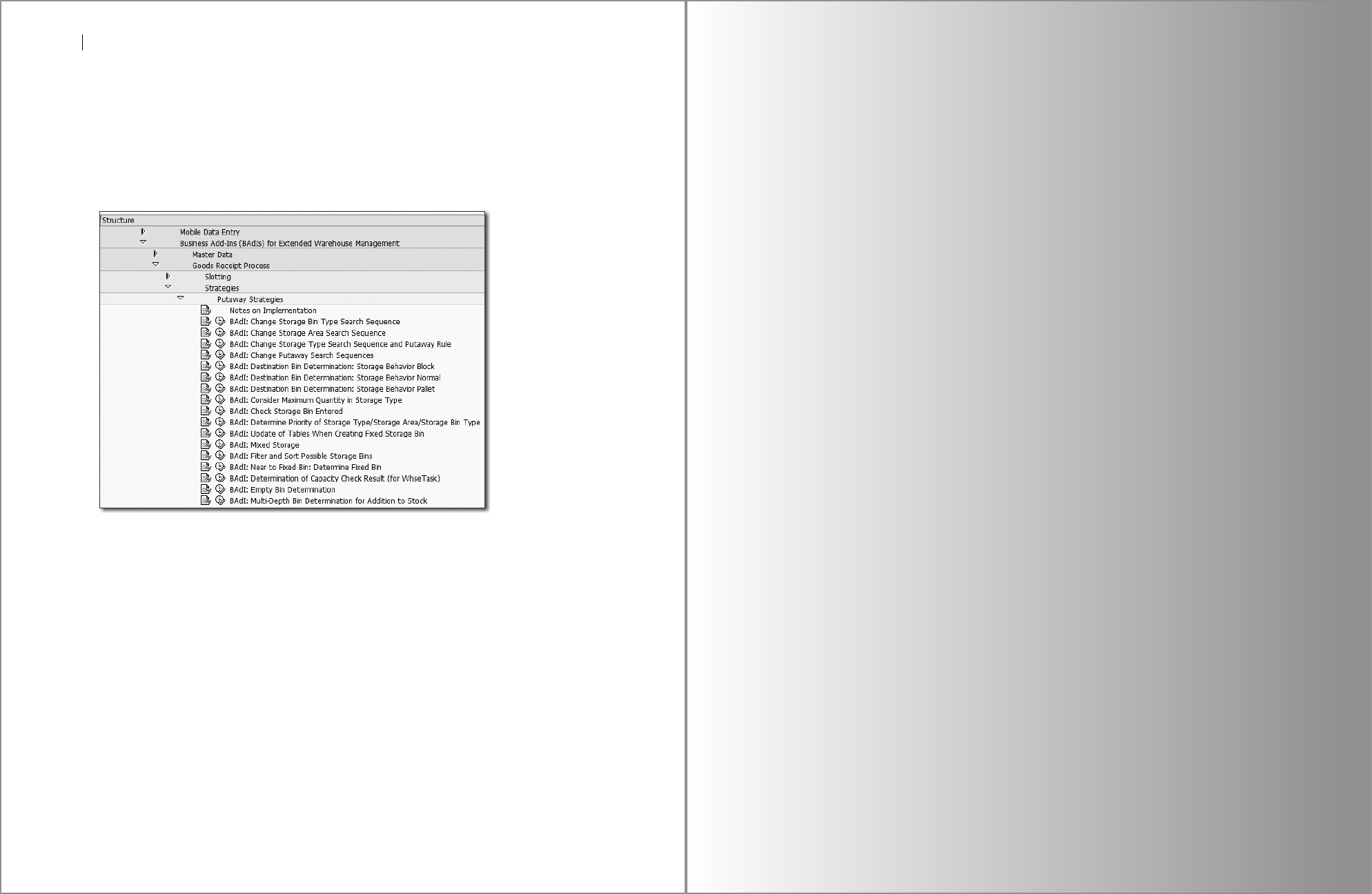
Architecture
2
70
used. If you cannot find the packaging specification, use the capacity information
if the product master of base UOM is used. Products with catch weight are the
exception. In that case, the quantity of capacity relevant UOM is used.
An influence of all parameters of the putaway strategy is possible via BAdI imple-
mentation. An overview of the available BAdIs is given in Figure 2.12.
Figure 2.12 Business Add-Ins for Putaway Strategy
2.3 Inventory Management
Inventory data and hierarchies in SAP EWM are stored on the Lean Inventory
Management Engine (LIME). The structure model of SAP EWM and LIME con-
tains three object types:
왘 Location
왘 HU
왘 Stock
The objects of these types form a hierarchy, with stock always stored in HUs. HUs
can contain other HUs and an HU is always anchored on a location. An example
is shown in Figure 2.13.

7
Contents
Foreword ......................................................................................................... 13
Introduction ..................................................................................................... 15
Acknowledgments ............................................................................................ 19
1 Flexible Warehouse Management with Extended
Warehouse Management .......................................................... 21
1.1 Warehouse Management with Standardized Software:
Configuration and Enhancement .................................................... 21
1.2 Flexibility of Extended Warehouse Management ........................... 22
1.2.1 Activity Areas: Flexible Assignment of Storage Bins to
Work Areas for Warehouse Operators .............................. 23
1.2.2 Storage Control: Modeling Multistep Warehouse
Processes ......................................................................... 24
1.3 Summary ....................................................................................... 26
2 Architecture ............................................................................... 29
2.1 Delivery Processing ........................................................................ 30
2.1.1 Function of the Delivery Processing .................................. 31
2.1.2 Object Warehouse Request and Data Model .................... 33
2.1.3 Integration with Other SAP EWM Components ................ 47
2.2 Warehouse Logistics ...................................................................... 50
2.2.1 Shipping and Receiving .................................................... 51
2.2.2 Warehouse Task and Warehouse Order ............................ 57
2.3 Inventory Management ................................................................. 70
2.3.1 Locations ......................................................................... 72
2.3.2 Handling Units ................................................................. 73
2.3.3 Stock ................................................................................ 74
2.4 Quality Management ..................................................................... 80
2.4.1 Function ........................................................................... 80
2.4.2 Objects and Data Model .................................................. 88
2.4.3 Integration ....................................................................... 89
2.5 Integration with SAP ERP .............................................................. 91
2.5.1 SAP ERP Systems .............................................................. 92
2.5.2 Non-SAP ERP Systems ...................................................... 119
2.6 Summary ....................................................................................... 125
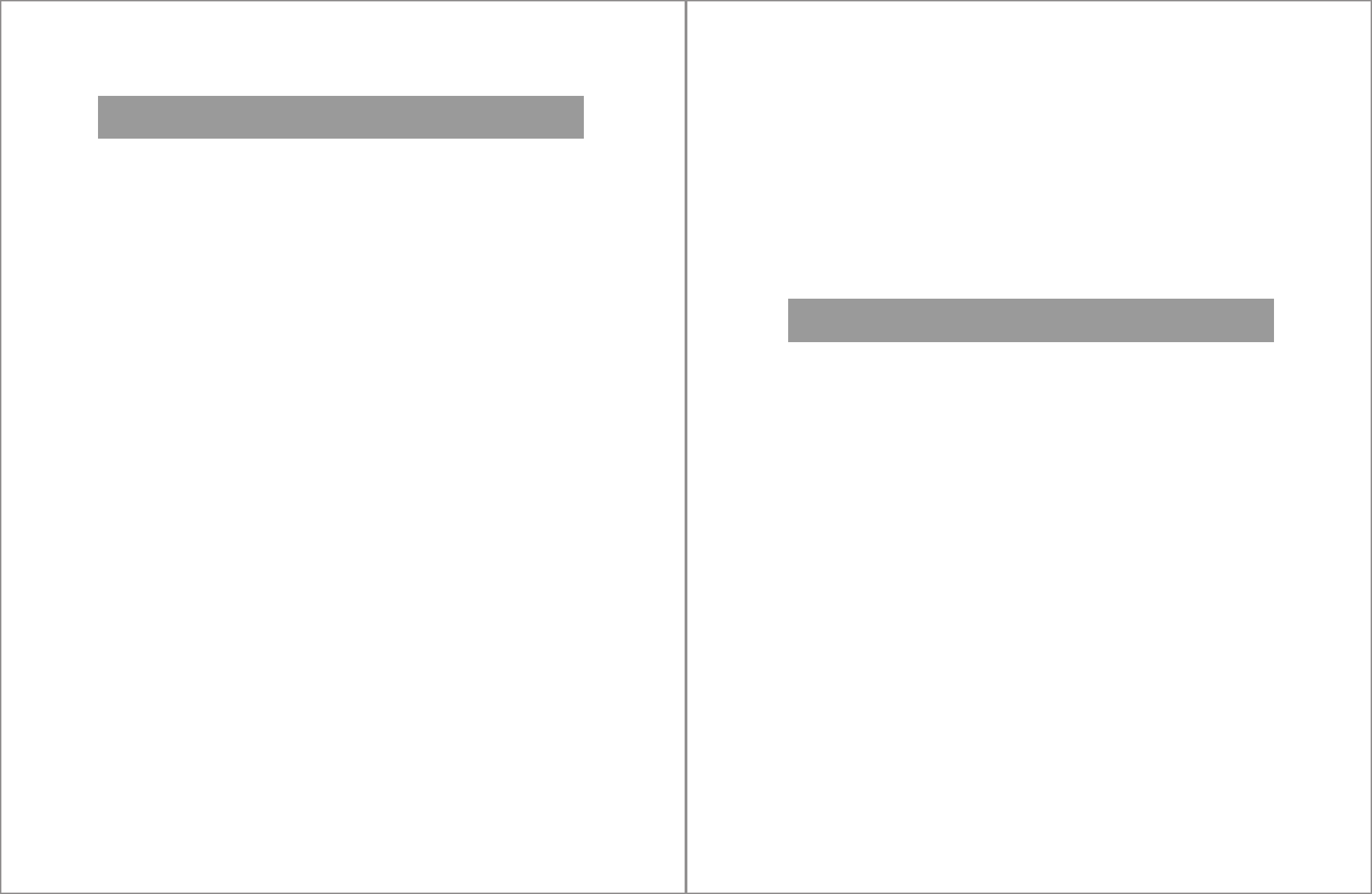
8
Contents
3 Frameworks and Development Tools in Extended
Warehouse Management .......................................................... 127
3.1 Warehouse Management Monitor ................................................. 127
3.1.1 Basics and Technical Structure .......................................... 128
3.1.2 Enhancement Options ...................................................... 136
3.2 Easy Graphics Framework and Measurement Services .................... 138
3.2.1 Foundations ..................................................................... 139
3.2.2 Custom Development: Basic Measurement Service ........... 141
3.2.3 Adjust Chart Template ...................................................... 148
3.2.4 Custom Development: Easy Graphics Framework
Object Service Provider .................................................... 149
3.3 Radio Frequency Framework ......................................................... 157
3.3.1 Basics ............................................................................... 158
3.3.2 Radio Frequency Framework and the Web Dynpro ABAP
Transaction ...................................................................... 163
3.3.3 Create a New Display Profile ............................................ 165
3.3.4 Create a New Radio Frequency Menu .............................. 169
3.3.5 Specification and Design of a New Radio
Frequency Transaction ...................................................... 170
3.3.6 Realization of the New Radio Frequency Transaction
in the System ................................................................... 173
3.3.7 Realization of a Verification Profile ................................... 187
3.3.8 Value Helps in Radio Frequency with Function Key F8 ..... 191
3.3.9 Realization of Lists ........................................................... 192
3.3.10 Exception Handling in Radio Frequency ............................ 198
3.3.11 Process Functions in Background Mode in Radio
Frequency Transactions .................................................... 204
3.3.12 Enhance Standard Radio Frequency Transactions and
the Use of Radio Frequency Business Add-Ins ................... 204
3.4 Post Processing Framework ........................................................... 206
3.4.1 What is the Post Processing Framework ........................... 206
3.4.2 Extended Warehouse Management and Post Processing
Framework ....................................................................... 208
3.4.3 Enhancement Options of the Post Processing
Framework ....................................................................... 215
3.5 Easy Enhancement Workbench ...................................................... 220
3.5.1 Introduction to Easy Enhancement Workbench ................ 220
3.5.2 Extended Warehouse Management and Easy
Enhancement Workbench ................................................ 222
Contents
9
3.5.3 Extended Warehouse Management and Easy
Enhancement Workbench Structure Enhancements .......... 226
3.6 Work Center .................................................................................. 230
3.6.1 Basics and Architecture .................................................... 230
3.6.2 Enhancing the Entry Screen .............................................. 237
3.6.3 Custom Development: Change Icons in the
Tree Control ..................................................................... 238
3.6.4 Custom Development: New Tab in Scanner Area .............. 239
3.6.5 Custom Development: Close Handling Unit ...................... 244
3.6.6 Custom Development: Packing of Inbound Deliveries ....... 247
3.7 Summary ....................................................................................... 251
4 Extending Processes in the Preconfigured
Warehouse W001 ..................................................................... 253
4.1 Introduction to Preconfigured Warehouse for Extended
Warehouse Management ............................................................... 254
4.1.1 Functional Scope of the Preconfigured Warehouse ........... 255
4.1.2 Overview of Custom Developments within the
Processes ......................................................................... 260
4.1.3 Installation of Preconfigured Warehouse .......................... 261
4.1.4 Testing Preconfigured Warehouse with
Solution Manager ............................................................. 262
4.2 Inbound Process with Repacking for Putaway (106) ....................... 265
4.2.1 Process Description 106 ................................................... 266
4.2.2 Custom Development 106A: Permit Activation of
the Transportation Unit Only after Entering the
License Plate and Pager .................................................... 268
4.2.3 Custom Development 106B: Delay Inbound Delivery
with Missing Batch ........................................................... 274
4.2.4 Custom Development 106C: Putaway Depending on
Quarantine Period ............................................................ 282
4.2.5 Custom Development 106D: Enhancing the
Warehouse Monitor ......................................................... 287
4.3 Inbound Process without Packing Information (107) ...................... 301
4.3.1 Process Description 107 ................................................... 302
4.3.2 Custom Development 107A: Automatic Handling
Unit Creation without Packaging Specifications ................ 303
4.3.3 Extension 107B: Simplify the Screen Flow for Radio
Frequency Putaway .......................................................... 314
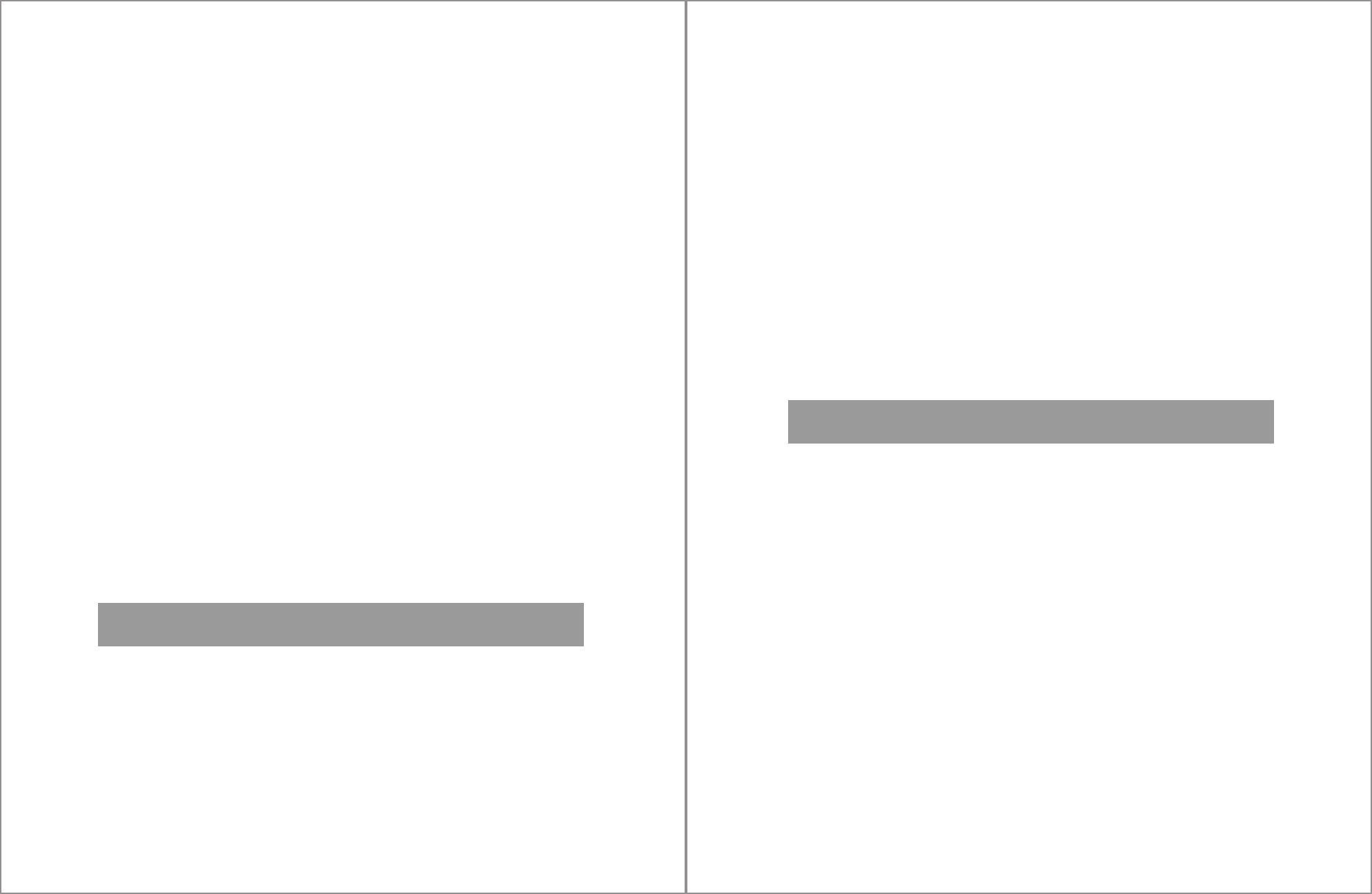
10
Contents
4.4 Outbound Process Using Pick Handling Units as Shipping
Handling Units (108) ..................................................................... 320
4.4.1 Process Description 108 ................................................... 321
4.4.2 Custom Development 108A: Enhancing the Delivery
Interface by Custom Data ................................................. 323
4.4.3 Custom Development 108B: Transfer of Custom Data
from ODO to Warehouse Task ......................................... 328
4.4.4 Custom Development 108C: Showing Custom Data in
the Form View of the ODO Item ...................................... 330
4.4.5 Custom Development 108D: Determination and
Transfer of Handling Unit Type from Packaging
Specification to Pick Warehouse Task ............................... 333
4.4.6 Custom Development 108E: Determination of the
Operative Unit of Measure by Packaging Specification
of Goods Receipt .............................................................. 338
4.4.7 Custom Development 108F: Prohibit Goods Issue for
Incomplete Packing .......................................................... 342
4.5 Outbound Process Using Wave, Pick Handling Units, Packing,
Staging, and Loading (109) ............................................................ 345
4.5.1 Process Description 109 ................................................... 345
4.5.2 Custom Development 109A: Take over Transportation
Unit after Unloading ......................................................... 348
4.5.3 Custom Development 109B: Print Picking Labels on a
Mobile Printer .................................................................. 362
4.6 Periodic Physical Inventory (110) ................................................... 373
4.6.1 Process Description 110 ................................................... 373
4.6.2 Custom Development 110A: Enhancing the Goods
Movement Interface by Additional Data ........................... 374
4.7 Summary ....................................................................................... 382
5 Functions Modules and Methods for Extended
Warehouse Management .......................................................... 383
5.1 Transaction Manager for a Logical Unit of Work in Extended
Warehouse Management ............................................................... 384
5.2 Service Class for Filling Stock Fields ............................................... 386
5.3 Date and Time for Time Zone of Warehouse Number .................... 387
5.4 Cross Application Constants .......................................................... 388
5.5 Create and Extend Application Log ................................................ 389
5.6 Read Warehouse Requests ............................................................. 391
Contents
11
5.7 Change Warehouse Requests ......................................................... 393
5.8 Read Warehouse Product Master .................................................. 395
5.9 Create/Change Warehouse Product Master Records ...................... 396
5.10 Service Class Batch Management ................................................... 398
5.11 Read Warehouse Task ................................................................... 400
5.12 Create/Confirm and Cancel Warehouse Task .................................. 400
5.13 Select Handling Units from DB ...................................................... 402
5.14 Create and Change Handling Units ................................................ 404
5.15 Get Stock ...................................................................................... 405
5.16 Posting Change of Stock ................................................................ 407
5.17 Select, Release, Split, and Merge Waves ........................................ 410
5.18 Get Transportation Units ............................................................... 414
5.19 Change TU .................................................................................... 416
5.20 Read and Determine Packaging Specifications ............................... 417
5.21 Create/Change/Copy/Delete Packaging Specifications .................... 418
5.22 Service Class for Radio Frequency Framework ................................ 418
5.23 Summary ....................................................................................... 419
6 Useful Business Add-Ins within Extended
Warehouse Management .......................................................... 421
6.1 Warehouse Request ....................................................................... 423
6.1.1 Enhancement Spot /SCWM/ES_ERP_MAPIN .................... 424
6.1.2 Enhancement Spot /SCWM/ES_ERP_ERROR_
HANDLING ...................................................................... 425
6.1.3 Enhancement Spot /SCWM/ES_ERP_INT_CONF ............... 425
6.1.4 Enhancement Spot /SCWM/ES_ERP_PROD ...................... 426
6.1.5 Enhancement Spot /SCWM/ES_ERP_PRIOP ...................... 427
6.1.6 Enhancement Spot /SCDL/TS_EXT .................................... 427
6.1.7 Enhancement Spot /SCWM/ES_DLV_DET ......................... 429
6.1.8 Enhancement Spot /SCWM/ES_CORE_CONS ................... 430
6.1.9 Enhancement Spot /SCWM/ES_DLV_EGR2PDI ................. 430
6.1.10 Enhancement Spot /SCWM/ES_ERP_MAPOUT ................. 431
6.2 Wave ............................................................................................. 434
6.2.1 Composite Enhancement Spot /SCWM/ES_WAVE ............ 434
6.3 Warehouse Task ............................................................................ 436
6.3.1 Enhancement Spot /SCWM/ES_CORE_CR –
Create Warehouse Task .................................................... 437
6.3.2 Enhancement Spot /SCWM/ES_CORE_RMS –
Stock Removal Strategy .................................................... 441

12
Contents
6.3.3 Enhancement Spot /SCWM/ES_CORE_PTS –
Putaway Strategies ........................................................... 447
6.3.4 Enhancement Spot /SCWM/ES_RSRC_QU –
RF: Resource Management Queue Determination ............ 456
6.3.5 Enhancement Spot /SCWM/ES_CORE_WT_RT –
Extract Time Determination in Warehouse Document ...... 456
6.3.6 Enhancement Spot /SCWM/ES_CORE_CO –
Confirmation of Warehouse Task ...................................... 457
6.4 Warehouse Order .......................................................................... 460
6.4.1 Enhancement Spot /SCWM/ES_WHO ............................... 462
6.5 Exception Handling ....................................................................... 469
6.5.1 Enhancement Spot /SCWM/ES_EXCP_EXC –
Exception Handling .......................................................... 469
6.6 Summary ....................................................................................... 472
473
Appendices ....................................................................................... 473
A Programming Guidelines in Extended Warehouse Management for
Enhancements .......................................................................................... 473
A.1 General Guidelines ........................................................................ 473
A.2 Naming Conventions for Data Dictionary ....................................... 475
A.3 Naming Conventions for Advanced Business Application
Programming Objects .................................................................... 476
A.4 Naming Conventions for Variables and Parameter .......................... 477
A.5 Performance Guidelines ................................................................. 477
A.6 Summary ....................................................................................... 479
B The Authors ............................................................................................. 481
Index................................................................................................................. 483

483
Index
A
ABAP dictionary, 179
ABAP logic, 38, 131, 207, 214, 287
ABAP object navigator, 193
ABAP workbench, 289, 294
Action definition, 207, 209, 212–213, 217–
218
Action merging, 211
Action profiles, 207
Activity, 51
Activity areas, 23
ADD_NEW_FIELDS, 222
Advanced production integration, 31
Aggregated quantities, 35
ALV grid control, 128
Append structure, 327
Application, 158
Application log, 285, 389
Application parameter, 161, 178
Application platform (AP), 35
Architecture, 29
ARM, 86
Aspects, 38
Asynchronous, 274
Asynchronous processing, 206
Authorization control, 136
Automatic replenishment, 255, 260
Availability check, 107
Availability group, 124
Available and physical stock, 226
Available stock, 406
B
Background job, 410
BAdI, 234, 237, 245, 308, 351, 354, 382
/SCDL/TS_DATA_COPY, 327, 427
/SCDL/TS_DATA_COPY_O, 427
/SCWM/CL_EX_ERP_GOODSMVT_EXT, 376
/SCWM/EX_CORE_CO_CHECK_CONF, 457
/SCWM/EX_CORE_CO_HU_SAVE, 458
/SCWM/EX_CORE_CO_IMPORT, 458
BAdI (Cont.)
/SCWM/EX_CORE_CO_POST, 458
/SCWM/EX_CORE_CO_SN_FORCE, 459
/SCWM/EX_CORE_CO_UNP_OUTHU, 459
/SCWM/EX_CORE_CONS, 430
/SCWM/EX_CORE_CR_ABORT, 437
/SCWM/EX_CORE_CR_AQUA_DATA, 437
/SCWM/EX_CORE_CR_DEL_ITM, 438
/SCWM/EX_CORE_CR_INT_CR, 438
/SCWM/EX_CORE_CR_SCRAP_ZERO, 439
/SCWM/EX_CORE_CR_SN_COMBINE, 440
/SCWM/EX_CORE_CR_STOCK_ID, 440
/SCWM/EX_CORE_CR_UPD_TAB_DI, 441
/SCWM/EX_CORE_PTS_BTSQ, 447
/SCWM/EX_CORE_PTS_CAPACHECK, 454
/SCWM/EX_CORE_PTS_DET_PRIO, 447
/SCWM/EX_CORE_PTS_EMPTY_BIN, 455
/SCWM/EX_CORE_PTS_FILT_SORT, 448
/SCWM/EX_CORE_PTS_MD_ADDBIN, 455
/SCWM/EX_CORE_PTS_MIX, 448
/SCWM/EX_CORE_PTS_NBIN_BLK, 450
/SCWM/EX_CORE_PTS_NBIN_NRM, 449
/SCWM/EX_CORE_PTS_NBIN_PAL, 449
/SCWM/EX_CORE_PTS_NEAR_FB, 450
/SCWM/EX_CORE_PTS_SECSQ, 451
/SCWM/EX_CORE_PTS_SMAQ, 452
/SCWM/EX_CORE_PTS_SRTSQ, 452
/SCWM/EX_CORE_PTS_TYPSQ, 453
/SCWM/EX_CORE_PTS_UPD_TAB, 453
/SCWM/EX_CORE_PTS_VERIF, 454
/SCWM/EX_CORE_RMS_DELETE, 441
/SCWM/EX_CORE_RMS_DETERMINE, 442
/SCWM/EX_CORE_RMS_HU_QUAN, 443
/SCWM/EX_CORE_RMS_HUTYP, 442
/SCWM/EX_CORE_RMS_NEGATIVE, 443
/SCWM/EX_CORE_RMS_OPUNIT, 340, 444
/SCWM/EX_CORE_RMS_QCLA_STR, 445
/SCWM/EX_CORE_RMS_QUANTITY, 445
/SCWM/EX_CORE_RMS_STRATEGY, 446
/SCWM/EX_CORE_RMS_VERIFY, 446
/SCWM/EX_CORE_WT_RT, 456
/SCWM/EX_DLV_AVAIL_CHECK, 429
/SCWM/EX_DLV_DET_ADDMEAS, 429

484
Index
BAdI (Cont.)
/SCWM/EX_DLV_DET_AFTER_CHANGE,
429
/SCWM/EX_DLV_DET_AFTER_SAVE, 429
/SCWM/EX_DLV_DET_AT_SAVE, 429
/SCWM/EX_DLV_DET_GM_BIN, 429
/SCWM/EX_DLV_DET_HIER_CORR, 429
/SCWM/EX_DLV_DET_LOAD, 429
/SCWM/EX_DLV_DET_POD_REL, 429
/SCWM/EX_DLV_DET_PROCTYPE, 429
/SCWM/EX_DLV_DET_REJ, 429
/SCWM/EX_DLV_DET_ROUTE, 429
/SCWM/EX_DLV_EGR2PDI_AFTERCOPY,
430
/SCWM/EX_DLV_EGR2PDI_COMPARE, 430
/SCWM/EX_DLV_EGR2PDI_TEXT, 430
/SCWM/EX_DLV_EGR2PDI_VAL, 430
/SCWM/EX_DLV_GM, 343
/SCWM/EX_DLV_UI_SCREEN, 331
/SCWM/EX_ERP_ERROR_QUEUE, 425
/SCWM/EX_ERP_GOODSMVT_EXT, 373
/SCWM/EX_ERP_INT_CONF, 425
/SCWM/EX_ERP_MAPIN_ID_REPLACE, 424
/SCWM/EX_ERP_MAPIN_ID_SAVEREPL,
424
/SCWM/EX_ERP_MAPIN_OD_SAVEREPL,
424
/SCWM/EX_ERP_MAPOUT_DELINFO, 431
/SCWM/EX_ERP_MAPOUT_ID_CONFDEC,
431
/SCWM/EX_ERP_MAPOUT_ID_REPLACE,
431
/SCWM/EX_ERP_MAPOUT_ID_REPLICA,
431
/SCWM/EX_ERP_MAPOUT_ID_SPLIT, 432
/SCWM/EX_ERP_MAPOUT_OD_CHANGE,
432
/SCWM/EX_ERP_MAPOUT_OD_CONFDEC,
432
/SCWM/EX_ERP_MAPOUT_OD_REPLICA,
432
/SCWM/EX_ERP_MAPOUT_OD_SPLIT, 432
/SCWM/EX_ERP_PRIOP, 427
/SCWM/EX_ERP_PROD, 426
/SCWM/EX_EXCP_EXC_BLKBINS, 469
/SCWM/EX_EXCP_EXC_FLT, 470
/SCWM/EX_EXCP_EXC_FLT_FOLLOUP, 471
/SCWM/EX_EXCP_EXC_FUNC, 471
BAdI (Cont.)
/SCWM/EX_HU_BASICS_HUHDR, 334
/SCWM/EX_MAPIN_OD_SAVEREPL, 323
/SCWM/EX_MSL_FILL_FD, 432
/SCWM/EX_MSL_FILL_PRD_INB, 432
/SCWM/EX_MSL_FILL_PRD_OUTB, 432
/SCWM/EX_MSL_FILL_SPC, 432
/SCWM/EX_MSL_MESSAGE_SORT, 432
/SCWM/EX_RF_FLOW_POST, 205
/SCWM/EX_RF_FLOW_PRE, 205
/SCWM/EX_RSRC_QU_DET, 456
/SCWM/EX_TOWHR_PTO_CREA, 328
/SCWM/EX_VAL_PROD_REF, 433
/SCWM/EX_WAVE_PLAN, 434
/SCWM/EX_WAVE_SAVE, 435
/SCWM/EX_WHO_CREATE, 462
/SCWM/EX_WHO_DSTGRP, 462
/SCWM/EX_WHO_FLT_IL, 463
/SCWM/EX_WHO_FLT_SL, 464
/SCWM/EX_WHO_HDR_PROCTY, 465
/SCWM/EX_WHO_LIM_OVERRULE, 465
/SCWM/EX_WHO_PACK_CHECK, 468
/SCWM/EX_WHO_PACK_DIM, 467
/SCWM/EX_WHO_PACK_DSTGRP, 467
/SCWM/EX_WHO_PACKING, 468
/SCWM/EX_WHO_PMAT_CHECK, 466
/SCWM/EX_WHO_PMAT_DET, 466
/SCWM/EX_WHO_SORT, 334, 463
/SCWM/EX_WRKC_PACK, 235
/SCWM/EX_WRKC_PACK_QTY_PROPOSE,
236
/SCWM/EX_WRKC_UI_AFTER_SAVE, 236,
244
/SCWM/EX_WRKC_UI_DEST_BIN, 235
/SCWM/EX_WRKC_UI_DETA_SCREENS, 236
/SCWM/EX_WRKC_UI_DETAIL_TABS, 236
/SCWM/EX_WRKC_UI_DETERMINE_HU,
235
/SCWM/EX_WRKC_UI_FLAG_REPACK, 235
/SCWM/EX_WRKC_UI_GET_WEIGHT, 235
/SCWM/EX_WRKC_UI_GUI_STATUS, 236
/SCWM/EX_WRKC_UI_HU_CHANGED, 235
/SCWM/EX_WRKC_UI_PAMT_FR_IDENT,
236
/SCWM/EX_WRKC_UI_PO_PROP, 236
/SCWM/EX_WRKC_UI_PRODUCTMASTER,
236
Index
485
/SCWM/EX_WRKC_UI_SCAN_SCREENS,
236, 243
/SCWM/EX_WRKC_UI_TREE_CONTROL,
236, 238
/SCWM/EX_WRKC_UI_WHTA_DCONS, 235
SMOD_V50B0001, 323
BAdI builder, 275, 335
BAPI_BATCH_SAVE_REPLICA, 117
BAPI_DELIVERY_GETLIST, 279
BAPI_MATERIAL_AVAILABILITY, 107
BAPI_OUTB_DELIVERY_CONFIRM_DEC, 106
BAPI_OUTB_DELIVERY_REJECT, 106
BAPI_OUTB_DELIVERY_SPLIT_DEC, 106
Barcode, 179, 188, 315
Batch, 115, 274, 399
characteristics, 287, 300, 399
class, 399
maintenance, 274
management, 274, 398
master, 276, 292
split item, 36, 342
status, 399
BMS, 140
Buffer, 292
Business context, 199
Business documents (BDocs), 221
Business logic, 55, 157
Business object (BO), 37
Business object processing framework (BOPF),
33
Business partner, 115
Business partner relationships (BUPR), 222
Business system group, 275
C
Capacity check, 69
Central model class, 244
CF, 282
Change request, 103, 106
Changing indicator, 270
Checkpoint group, 162, 178
/SCWM/WAVE, 434
/SCWM/WHO, 461
CIF model, 283
CL_MAP, 119
Class
/SCDL/CL_BO_MANAGEMENT, 393
/SCDL/CL_SP_PRD_OUT, 393
/SCWM/CL_BATCH_APPL, 398
/SCWM/CL_DLV_MANAGEMENT_DR, 391
/SCWM/CL_DLV_MANAGEMENT_FD, 391
/SCWM/CL_DLV_MANAGEMENT_PRD, 391
/SCWM/CL_DLVPACK_IBDL, 234
/SCWM/CL_EG_SP_MS, 140
/SCWM/CL_EGF_CHART_DATA, 140
/SCWM/CL_EI_WRKC_UI_AFTER_SAVE,
245
/SCWM/CL_EXCEPTION_APPL, 201
/SCWM/CL_LOG, 389
/SCWM/CL_MON_STOCK, 405
/SCWM/CL_RF_BLL_SRVC, 418
/SCWM/CL_SR_BO, 416
/SCWM/CL_SR_BOM, 416
/SCWM/CL_SR_DB_TU, 414
/SCWM/CL_SR_TU_QUERY, 414
/SCWM/CL_UI_STOCK_FIELDS, 386
/SCWM/CL_WM_PACKING, 180, 234, 244,
404
Class characteristics, 287
Class reference, 42
CLEANUP, 385
COMMIT, 385
Complex selection criteria, 39, 42–43
Composite enhancement spot
/SCWM/ESC_CORE, 437
/SCWM/ESC_MAIN, 421
/SCWM/ESC_WAVE, 434
Condition technique, 335
Confirmed WT, 66
Consolidation group, 62, 430
Constants, 388
/SCDL/IF_DL_C, 389
/SCWM/IF_DL_C, 389
WMEGC, 388, 401
WMESR, 388
Control parameters, 292
Core interface, 115, 121, 257
Core RF transactions, 205
Counting, 60
CRM condition technique, 214
Custom data, 424
Custom development, 253, 260, 268

486
Index
Custom field extensions, 220
Custom fields, 226
Custom message type, 432
Customer relationship management (SAP
CRM), 86, 91, 220, 222
Customizing includes, 221
Customizing tables, 26
Cycle counting, 255
D
Database inconsistencies, 384
Database selection, 388
Deconsolidation, 61
Delivery, 30, 50, 227
confirmation, 106
header, 35
interface, 92, 95, 121
item, 35
note, 321
object, 41
order, 228
processing, 29
query, 42–45
split, 103, 105
split item, 36, 46
synchronization, 355
terms, 40
Delivery documents, 30, 32, 42
Delivery request, 424
Design, 172
Destination data, 68
Destination HU, 239–240
Destination location, 65
Destination stock, 87
Difference Analyzer, 377
Display profile, 158
DLV, 282
Document architecture, 32
Document category, 30, 36, 42
Document flow, 45
Door, 56, 226, 268, 321, 348
Door bins, 52
Door determination, 54
Drill-down, 137
Dynamic processing, 281
E
Easy enhancement, 136
Easy enhancement workbench (EEW), 127,
136, 220, 222, 226
EEWB, 221
EEWC, 221
structure, 288
Easy graphics framework (EGF), 127, 251
object, 140, 148
object service providers, 149
Empty transaction, 174
Enhancement spot
/SCDL/TS_EXT, 427
/SCWM/ES_CORE_CO, 457
/SCWM/ES_CORE_CONS, 430
/SCWM/ES_CORE_CR, 437
/SCWM/ES_CORE_PTS, 447
/SCWM/ES_CORE_RMS, 441
/SCWM/ES_CORE_WT_RT, 456
/SCWM/ES_DLV_DET, 429
/SCWM/ES_DLV_EGR2PDI, 430
/SCWM/ES_DLV_GM, 343
/SCWM/ES_DLV_TOWHR, 329
/SCWM/ES_DLV_UI_SCREEN, 332
/SCWM/ES_ERP_ERROR_HANDLING, 425
/SCWM/ES_ERP_GOODSMVT, 376
/SCWM/ES_ERP_INT_CONF, 425
/SCWM/ES_ERP_MAPIN, 326, 424
/SCWM/ES_ERP_MAPOUT, 431
/SCWM/ES_ERP_PRIOP, 427
/SCWM/ES_ERP_PROD, 426
/SCWM/ES_EXCP_EXC, 469
/SCWM/ES_HU_BASICS, 335
/SCWM/ES_RSRC_QU, 456
/SCWM/ES_WHO, 334, 462
/SCWM/EX_CORE_RMS, 340
Enterprise service, 38
Entitled, 396
Entry screen, 237
ERP and EWM stock models, 118
ERP integration, 256, 262
ERP version control, 92
Exception code, 87, 198, 201
DIFF, 199
LIST, 199
NEXT, 198
SKFD, 199
Index
487
Exception handling, 198
Exceptions, 181
Expected goods receipt (EGR), 31, 104, 227
Expected goods receipt notification, 31
Extending processes, 253
F
Field control, 292
Final delivery, 424
Flexibility of software, 15, 22, 127
Floor plan manager (FPM), 229
Flow chart, 164
Follow-on documents, 428
Follow-up processing, 91
Freight order, 226
Function builder, 279
Function code, 161, 177
Function group, 161
/SCWM/RF_INQUIRY, 193
/SCWM/UI_PACKING, 240
ZBKS_WAVE_KPI, 142
ZRF_SORT, 174
ZUI_PACKING, 239
Function module, 48, 102, 136, 383, 387,
395–396, 400, 402, 407, 410, 417–418, 437
/SCWM/API_PACKSPEC_CHANGE, 418
/SCWM/API_PACKSPEC_COPY, 418
/SCWM/API_PACKSPEC_CREATE, 418
/SCWM/API_PACKSPEC_DELETE, 418
/SCWM/API_PACKSPEC_GETLIST, 417
/SCWM/API_PACKSPEC_READ, 417
/SCWM/CALL_PACKUI, 237
/SCWM/CONVERT_DATE_TIME, 387
/SCWM/CONVERT_TIMESTAMP, 387
/SCWM/HU_SELECT_GEN, 402
/SCWM/MATERIAL_READ_MULTIPLE, 395
/SCWM/MATERIAL_READ_RANGE, 395
/SCWM/MATERIAL_READ_SINGLE, 395
/SCWM/MATERIAL_WHST_MAINT_MULT,
396
/SCWM/PACKING_UI, 233
/SCWM/PS_FIND_EVALUATE_MULTI, 417
/SCWM/RF_*_EXCEPTION, 202
/SCWM/RF_EAN128_SPLIT_VALID, 188
/SCWM/RF_MATNR_VALID, 190
Function module (Cont.)
/SCWM/RF_PICK_BIN_CHECK, 187
/SCWM/RF_PICK_MATID_CHECK, 190
/SCWM/RSRC_USER_DEF_SET_GET, 192
/SCWM/STOCK_CHANGE, 407
/SCWM/TO_CANCEL, 400
/SCWM/TO_CONFIRM, 400
/SCWM/TO_CREATE, 400
/SCWM/TO_CREATE_MOVE_HU, 400
/SCWM/TO_GET_WIP, 400
/SCWM/TO_READ_MULT, 400
/SCWM/TO_READ_SINGLE, 400
/SCWM/WAVE_MERGE_EXT, 410
/SCWM/WAVE_RELEASE_EXT, 410
/SCWM/WAVE_SELECT_EXT, 410
/SCWM/WAVE_SPLIT_EXT, 410
/SCWM/WAVEHDR_O_MON, 143
/SCWM/WHO_CREATE, 462
G
Global trade services (SAP GTS), 50
Goods issue (GI), 77, 206, 321
Goods movement interface, 92, 108, 374, 376
Goods receipt (GR), 52, 58, 122
GUI status, 163
GUID (Global Unique Identifier), 71, 73, 387
H
Handheld device, 157
Handling unit (HU), 73, 226, 402, 404
Hanging queue entries, 425
Header identification, 35
Hierarchy elements, 36
Hotspots, 131
HTML templates, 180
HU type, 320, 333
I
Identification type, 269
Implementation Guide (IMG), 223, 230, 235,
243, 421

488
Index
Inactive delivery, 274
Inbound delivery, 31, 247, 302, 394
change, 103
notification, 30, 274
replication, 102
Inbound message processing, 96
Inbound process, 254, 264
Include
/SCWM/IRF_SSCR, 174
Index tables, 77
Indirect labor task, 226
Inspection, 84, 90
document, 82, 86
lot, 113
rules, 80, 82
Inspection object type (IOT), 88
Integration, 47, 89
Integration of non-SAP ERP systems, 91
Integration with SAP ERP, 29, 91
Intermediate document (IDoc), 55, 121
Internal action, 87
Internal process codes, 199
Inventory management, 29, 70, 407
Item category, 36
Item hierarchy, 46
Item identification, 35
Item text, 374
K
Key aspect, 38, 40
Keyboard scanner, 230
Kitting, 49
L
Languages, 175
Lean inventory management engine (LIME),
70, 73
LE-TRA, 94
License plate, 268
List, 192
Loading, 63, 321
Location independent stock type, 124
Location index, 72
LOG_LE_INTEGRATION, 93, 100, 105–107
Logical field names, 43
Logical system, 275
Logical unit of work (LUW), 206, 384–385,
401, 405
Logistics execution, 96
Low stock check, 204
M
Mass access, 387
Mass tests, 384
Master data, 49, 117, 222, 254, 262, 306
Master data layer, 395
Master guide for SAP EWM, 93
Master menu, 169
Material document, 376
Maturation, 283
MBGMCR, 109
MDL, 395
Measurement service, 133, 138
Memory, 401, 403
Message box, 39
Message class, 269
Z108, 343
Message control, 207
Message maintenance transaction, 284
Messagelog, 101–102
Method, 383
ABORT, 437
ASSIGN_CLASS, 431
CANCEL_BUFFERED_WT, 454
CHANGE, 334, 445
CHANGE_DATA, 437
CHANGE_WAVES, 435
CHECK_CONF, 457
CHECK_DOCUMENT, 343
CHECK_REFERENCE, 433
CHECK_SMAQ_LGTYPG, 452
CONF, 458
CONTROL_BLKBINS, 470
CUSTOM_CAPA_CHECK, 454
DECIDE_SMAQ_USE, 452
DEFINE_ITEM_EXTENSION, 332
DEL_ITM, 438
DELETE, 441
DELETE_EMPTY_BIN_BUFFER, 455
DET_DEST_BIN_BULK, 450
Index
489
Method (Cont.)
DET_DEST_BIN_NORMAL, 449
DET_DEST_BIN_PALLET, 450
DET_DOCTYPE, 426
DET_ERP_DLVTYPE, 426
DET_ERP_MESSAGES, 432
DET_ITEMTYPE, 426
DET_NEAR_FB, 451
DET_PRIORITIES, 447
DETERMINE, 442, 456
DETERMINE_BIN, 455
DETERMINE_EMPTY_BINS, 455
DSTGRP, 430, 462
EXECUTE_FUNCTIONS, 471
EXIT_SAPLV50K_007, 324
FILL_FIELDS, 434
FILT_SORT, 448
FILTER_EXCEPTION_CODES, 470
FILTER_FOLLOW_UP_ACTIONS, 471
FILTER_IL, 463
FILTER_SL, 464
FORCE, 459
HDR_PROCTY, 465
HU_QUAN, 443
HUTYP, 443
INSERT, 439
LIMIT_OVERRULE, 465
MAPIN, 424
MAPOUT, 432
MIX_ALLOWED, 448
MIX_CHECK, 448
MODIFY_ADDMEAS_HEAD, 428
MODIFY_ADDMEAS_ITEM, 428
MODIFY_DATE_HEAD, 428
MODIFY_DATE_ITEM, 428
MODIFY_DELTERM_ITEM, 428
MODIFY_EEW_HEAD, 428
MODIFY_EEW_ITEM, 428
MODIFY_HU, 428
MODIFY_INCOTERMS_HEAD, 428
MODIFY_PARTYLOC_HEAD, 428
MODIFY_PARTYLOC_ITEM, 428
MODIFY_PRCODES_ITEM, 428
MODIFY_PRODUCT_ITEM, 428
MODIFY_PRODUCT_ITEM_EXT, 428
MODIFY_REFDOC_HEAD, 428
MODIFY_REFDOC_ITEM, 428
MODIFY_STOCK_ITEM, 428
MODIFY_TRANSP_HEAD, 428
Method (Cont.)
NEGATIVE, 444
OPUNIT
, 340, 444
PACK_CHECK, 468
PACK_DIMENSION, 467
PACK_DSTGRP, 468
PACKING, 469
PMAT_CHECK, 466
PMAT_DETERMINATION, 466
POST, 459
PRODUCT_ADD, 426
PRODUCT_CREATE, 426
PUBLISH_Q_ERROR, 425
QUANTITY, 445
REACHTIME_OVERWRITE, 457
SAVE, 427
SCRAP_ZERO, 439
/scwm/cl_rf_bll_srvc=>init_listbox, 191
/scwm/cl_rf_bll_srvc=>insert_listbox, 191
/scwm/cl_rf_bll_srvc=>set_prmod, 204
/SCWM/CL_RF_BLL_SRVC=>set_scr_
tabname, 194
SN_COMBINE, 440
SORT, 334, 433
SORT_SEQUENCE, 452
STOCK_ID, 440
STORAGE_BINTYPE_SEQ, 447
STORAGE_SECTION_SEQ, 451
STORAGE_TYPE_SEQ, 453
STRATEGY, 446
UNPACK_OUTER_HU, 460
UPD_TABLES_DEL_ITEM, 441
UPDATE_TABLES, 453
VERIFY, 446
MFS telegram, 226
Middleware, 120
Mobile device, 157
Mobile printer, 364
Monitor node, 299
Monitor tree, 134
Monitoring, 127
N
Node hierarchy, 134, 299
Node profile, 299
Non-SAP ERP systems, 119

490
Index
O
Object instance, 33, 45
Object manager, 42
Object navigator, 168
Organizational data, 64
Outbound delivery, 31, 229
Outbound delivery order (ODO), 31, 44, 344,
394
form view, 320, 331
goods issue, 342
Outbound delivery request (ODR), 30, 323,
327
Outbound message processing, 96
Outbound process, 254, 265, 348
P
Pack profile, 333
Package
/SCWM/PACKING, 233
Packaging material, 307, 333, 336
Packaging specification, 226, 228, 304, 320,
333, 418
level, 339
Packing, 63
Pager number, 268
PAI, 163
PAI modules, 241
Parallel WT, 67
PBO, 163
PBO module, 240
Performance, 292, 384, 386–387, 405–406,
411
Periodic physical inventory, 17, 254–255, 373
Personalization profile, 159
Physical inventory
document, 373
low stock check, 373
periodic, 373
product based, 373
putaway, 373
stock differences, 373
storage bin based, 373
Physical stock, 406
Pick handling unit (Pick HU), 239–240, 321,
333
Pick path, 62
Pick-by-voice, 157
Picking, 62–63
Picking label, 362, 364, 371
Picking strategy, 67
Planned HU, 250
Planned WT, 64, 66
Post processing framework (PPF), 50, 55, 127,
206, 215
action, 53
action definition, 208–209
applications, 208
delivery processing, 217
manager, 208
merging, 211
processing time, 210
schedule condition, 213
start condition, 213
trigger, 208, 211
Posting change, 31, 96, 407
Posting change request, 31
Preceding documents, 32
Preconfigured Warehouse, 253, 263, 333,
373, 380
functional scope, 255
installation, 261
introduction, 254
organizational structure, 256
process flows, 257
testing, 262
Preliminary inspection, 89
Presentation device, 165
Presentation profile, 159, 316
Process functions, 204
Processing delivery, 424
Process-oriented storage, 25, 58, 63, 259
Product inspections, 81
Product master, 395
Product master record, 396, 426
Production date, 287
Production material request, 31, 96, 100
Putaway, 58, 61, 255
Putaway control indicator, 282, 285
Putaway strategy, 69, 282
Index
491
Q
QIE_COMMUNICATION, 112
QIE_RFC_CONF_CANCEL_EXT_INSP, 113
QIE_RFC_CONF_EXT_INSP, 113
QIE_RFC_NOTIFY_RES_EXT_INSP, 114
QIE_RFC_STATUS_INFO_EXT_INSP, 114
QM interface, 92, 111
QPLEXT_COMM_TEC, 113
QPLEXT_RFC_INSP_LOT_CANCEL, 114
QPLEXT_RFC_INSP_LOT_CHANGE, 114
QPLEXT_RFC_INSP_LOT_CREATE, 114
Quality control, 61, 86
Quality inspection, 61, 88, 233, 255
Quality inspection document, 226
Quality inspection engine (QIE), 50, 80, 85,
88, 111, 209
Quality management (QM), 29, 80, 83, 259
Quant, 74
Quant separation, 49
Quantity classification, 304, 308, 339
Quantity offsetting, 45
Quantity role, 44–45, 47
Quarantine period, 283
Queue, 282
Queue deregistration, 124
Queue name, 401
Queue prefixes, 401
Queued remote function call (qRFC), 112,
121, 220, 401
R
Radio frequency, 60, 179
Radio frequency framework (RFF), 127, 174,
184, 191, 251, 418
Read options, 279
Reason for movement, 374, 376
Receiving, 258
Reference, 374
Reference document, 35, 76
Release upgrade, 384
Remote-enabled module, 279
Repack HU, 235–236
Repacking, 265
Report
/SCWM/RCALL_PACK_IBDL, 233
/SCWM/RCALL_PACK_OBDL, 233
/SCWM/RHU_PACKING, 233
/SCWM/RPACKENTRY, 232
/SCWM/RPOPACKENTRY, 233
/SCWM/RQINSPENTRY, 233
/SCWM/RSPREADENTRY, 232
/SCWM/RVASENTRY, 233
ZRCALL_PACK_IBDL, 248
Resource management, 255
RF cookbook, 158
RF device, 200
RF environment, 157, 159
RF menus, 158
RF putaway, 301
RF template screens, 167
RF transaction, 89, 157, 170, 173
RFC connection, 275
ROLLBACK, 385
Rollback, 49
Route, 321
Route determination, 50
Routing, 83
S
SAP Basis, 206
SAP Chart Designer, 148
SAP Community Network (SCN), 21, 208
SAP ECC, 424
SAP EWM, 21, 253
SAP EWM PID, 375
SAP GUI, 180, 191, 233
SAP Help Portal, 264, 303
SAP ITSmobile, 158
SAP List Viewer (ALV), 227
SAP NetWeaver, 206
SAP Solution Manager, 254, 256, 262
/SAPAPO/CIF_BATCH_INBOUND, 117
/SAPAPO/CIF_CLAF_INB, 117
/SAPAPO/CIF_LOC_INBOUND, 116
/SAPAPO/CIF_PROD_INBOUND, 116
Scanner area, 231
Schedule condition, 208, 215, 217

492
Index
SCM master data, 222–223
Screen BAdI, 230
Screen painter, 168, 289
/SCWM/ACTLOG, 390
/SCWM/CL_ACC_ERP, 107
/SCWM/CL_AVAIL_CHECK_ERP, 107
/SCWM/CL_DEF_IM_ERP_INT_CONF, 275
/SCWM/CL_DISPA_W2IM_GOODSMVT, 109
/SCWM/CL_MAPIN, 97
/SCWM/CL_MAPOUT, 102
/SCWM/CL_MAPOUT_ID_CONF_DEC, 104
/SCWM/CL_MAPOUT_ID_REJECT, 104
/SCWM/CL_MAPOUT_ID_REPLACE, 103
/SCWM/CL_MAPOUT_ID_REPLICA, 102
/SCWM/CL_MAPOUT_ID_RESPONSE, 103
/SCWM/CL_MAPOUT_ID_SPLIT_DEC, 103
/SCWM/CL_MAPOUT_OD_CONF_DEC, 106
/SCWM/CL_MAPOUT_OD_REJECT_CRM,
106
/SCWM/CL_MAPOUT_OD_SAVEREPLICA,
105
/SCWM/CL_MAPOUT_OD_SPLIT_DEC, 105
/SCWM/CL_TM, 384
/SCWM/ERP_EGR_DELETE, 104
/SCWM/ERP_INTEGRATION, 92, 108
/SCWM/ERP_STOCKCHECK, 109
/SCWM/ERP_STOCKID_MAPPING, 119
/SCWM/ERP_TM_INTEGRATION, 109
/SCWM/ERPDETERMINATION, 94
/SCWM/ERPVALIDATION, 94
/SCWM/ES_CORE_PTS, 284
/SCWM/ES_DLV_UI_SCREEN, 227
/SCWM/ES_ERP_INT_CONF, 275
/SCWM/ES_ERP_MAPIN, 97
/SCWM/ES_GR, 227
/SCWM/ES_PS_UI, 228
/SCWM/ES_SR_READ_SAVE, 270
/SCWM/ES_VAS_UI, 228
/SCWM/EX_CORE_PTS_TYPSQ, 284
/SCWM/EX_ERP_INT_CONF, 275
/SCWM/EX_SR_SAVE, 270
/SCWM/GET_STOCKID_MAP_INSTANCE,
119
/SCWM/IDOC_INPUT_SHPMNT, 110
/SCWM/IDOC_OUTPUT_GOODSMVT_CR,
109
/SCWM/IDOC_OUTPUT_IBDLV_CONFDC,
104
/SCWM/IDOC_OUTPUT_OBDLV_CONFDC,
106
/SCWM/IDOC_OUTPUT_OBDLV_SPLTDC,
105
/SCWM/IDOC_OUTPUT_SHIPPL, 111
/SCWM/IDOC_OUTPUT_SHPMNT, 111
/SCWM/INB_DELIVERY_REPLACE, 98
/SCWM/INB_DLV_SAVEREPLICA, 98, 104–
105
/SCWM/INB_PO, 99
/SCWM/IPU, 418
/SCWM/OBDLV_CHNG_QUAN_MUL, 100
/SCWM/OUTB_DLV_CANCELLATION, 100
/SCWM/OUTB_DLV_CHANGE, 100
/SCWM/OUTB_DLV_SAVEREPLICA, 99
/SCWM/PRODUCTION_WHR_MAINTAIN,
100
/SCWM/SR_INVOICE_CREATE, 107
/SCWM/VALUATION_SET, 117
/SCWM/WM_BATCH_MAINT, 117
/SCWM/WME, 390
Selection criteria, 295
Selection screen, 291
Selection variant, 132, 137
Service provider, 394
Service-oriented architecture (SOA), 33
Service-provider (SP), 37
Shipment, 226
Shipment interface, 92, 109
Shipping, 260
Shipping and receiving (S&R), 49, 54, 208, 362
Shipping cockpit (SCO), 229
SHP_IBDLV_CONFIRM_DECENTRAL, 104
SHP_OBDLV_CONFIRM_DECENTRAL, 106
SHP_OBDLV_SPLIT_DECENTRAL01, 106
SHPMNT05, 109–110
SMOD_V50B0001, 97
SMQ2, 282
SMQR, 281
Sort order, 24
Sort sequences, 23
Source data, 66
Source location, 65
/SPE_INB_DELIVERY_RESPONSE, 98
/SPE/AAC_DETERMINATION, 107
/SPE/BATCH_SAVE_REPLICA, 117
Specification, 170
/SPE/CL_DLV_DISPATCH, 97
Index
493
/SPE/CREATE_NEW_BILLING_CALL, 107
/SPE/GOODSMVT_CREATE, 108–109
/SPE/INB_CALL_TRX_VL60, 105
/SPE/INB_DELIVERY_CONFIRM_DEC, 104
/SPE/INB_DELIVERY_REPLACE, 103
/SPE/INB_DELIVERY_RESPONSE, 103
/SPE/INB_DELIVERY_SAVEREPLICA, 102
/SPE/INB_DELIVERY_SPLIT, 103
/SPE/INB_EGR_CREATE_POSA, 105
/SPE/INB_EGR_CREATE_PROD, 104
/SPE/INSP_MAINTAIN_MULTIPLE, 115
/SPE/MATERIAL_STOCK_READ, 109
/SPE/OUTB_DELIVERY_SAVEREPLICA, 105
Splitting the WT, 64
SSCC barcode, 188
Staging, 63
Staging area, 321
Start condition, 208, 218
Step flow, 165
Stock, 74, 405
attributes, 64, 299, 407
fields, 386
identification, 75, 180
index table, 76
management, 259–260
mapping, 124
separation, 76
transfer, 31
type, 119, 407
type role, 124
Stock identification (SI), 362, 403
Storage control, 24
Storage requirements, 22
Storage section indicator, 282
Storage type search sequence, 283, 285
Structure
ET_EXTENSION1, 324
ET_EXTENSION2, 324
/SCDL/INCL_EEW_DLV_ITEM_STR, 323,
331
/SCDL/INCL_EEW_DR_ITEM_STR, 323, 325
/SCWM/INCL_EEW_S_ORDIM, 328
/SCWM/INCL_EEW_S_WT_CREA, 328
/SCWM/S_ORDIM_ATT, 329
Success message, 181
Supply chain management (SAP SCM), 220,
225
Supply chain unit, 335
Support package upgrade, 384
Synchronous processing, 206
T
Table
/SCWM/ORDIM_O, 330
Tailored measurement service (TMS), 140
Template screens, 168
Time zone, 387
TPSSHT01, 111
Transaction
MB03, 381
/SCWM/CAP, 233
/SCWM/DCONS, 232
/SCWM/DIFF_ANALYZER, 381
/SCWM/EGF, 147
/SCWM/EGF_CHART, 148
/SCWM/EGF_COCKPIT, 155
/SCWM/EGF_OBJECT, 147, 154
/SCWM/MON, 233
/SCWM/PACK, 232
/SCWM/PACKSPEC, 333
/SCWM/PI_DOC_CREATE, 381
/SCWM/PRDI, 233
/SCWM/PRDO, 233, 332
/SCWM/QINSP, 233, 239
/SCWM/RFUI, 157
/SCWM/SEBA, 333
/SCWM/TLR_WIZARD, 145
/SCWM/VASEXEC, 233
/SCWM/WM_ADJUST, 377
SE11, 151, 179, 325
SE19, 245, 324, 334
SE24, 149
SE37, 202
SE38, 248
SE51, 165
SE55, 151
SE80, 142, 168, 179, 193, 199
SE91, 344
SM12, 180
SM30, 151
SOLAR_PROJECT_ADMIN, 262
SOLAR01, 263
SOLAR02, 263

494
Index
Transaction manager, 384
Transactional RFC, 220
Transfer service, 32
Transition service, 327
Transportation unit (TU), 50–51, 226, 268,
414, 416
Tree control, 170, 231, 238
Truck, 321
U
Unit of measure (UOM), 67, 304
alternative, 338
base, 339
operative, 320, 338–339
Unloading, 59
with storage process, 59
without storage process, 59
User interface (UI), 37, 157
V
Validation objects, 187–188
Validation profile, 160, 187–188
Value-added service (VAS), 49, 61, 63, 233
Variant maintenance, 132
VAS order, 226, 228
Vehicle, 226
Vendor batch, 287
Verification field, 187
Verification profile, 187
Virtual stock, 72
W
Warehouse activities, 32
Warehouse cockpit, 138, 148
Warehouse logistics, 29, 50, 259
Warehouse management monitor, 127, 251,
272, 287
category nodes, 129
enhancements, 138
hotspots, 131
methods presentation, 131
Warehouse management monitor (Cont.)
monitor methods, 131
node hierarchy, 130
node hierarchy tree, 129
profile nodes, 129
variant node, 132
Warehouse monitor, 338, 382
Warehouse number, 71, 74, 76, 387
Warehouse order (WO), 57
Warehouse order creation rule, 333
Warehouse process category, 57
Warehouse process type, 62, 87
Warehouse product, 396
Warehouse request, 30, 32, 226, 228, 392,
423
change, 393
read, 391
Warehouse request management, 258–259
Warehouse request processing, 30
Warehouse task (WT), 25, 50, 57, 226, 400
Wave, 345
Wave determination, 434
Wave functionality, 62
Wave management, 410
Web Dynpro, 229
Web Dynpro ABAP, 163
Wildcard logic, 133
Wizard, 158
WM Execution, 283
WO printing, 364, 367
Work center, 127, 230, 243, 248, 251
Workflow conditions, 212
WT processing, 47
Y
Yard, 51
Yard management, 52, 54
Z
ZSORT, 172, 174, 183, 188, 190, 192, 200,
371
ZSWAP, 350, 360
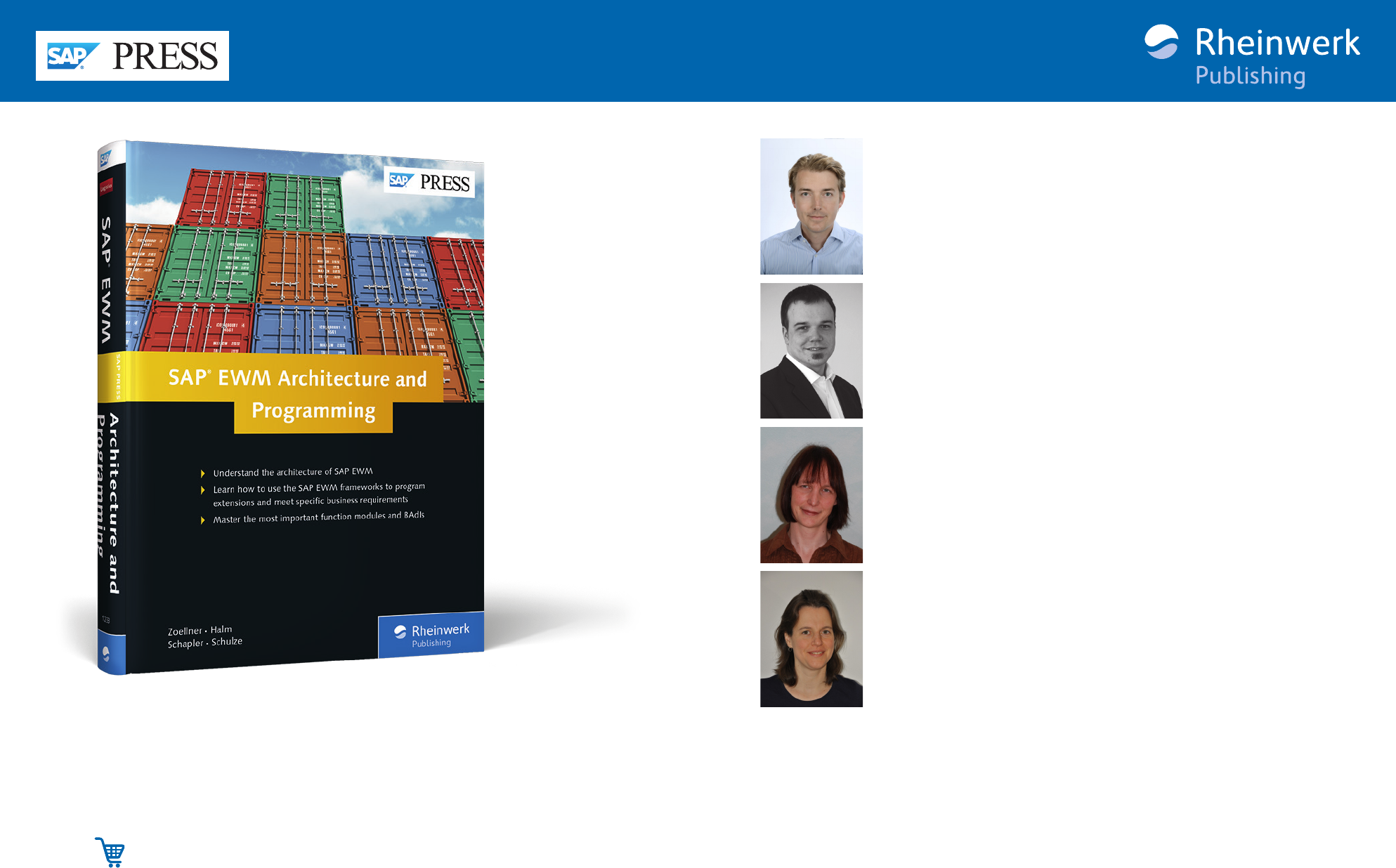
First-hand knowledge.
We hope you have enjoyed this reading sample. You may recommend
or pass it on to others, but only in its entirety, including all pages. This
reading sample and all its parts are protected by copyright law. All usage
and exploitation rights are reserved by the author and the publisher.
Peter Zoellner joined SAP Consulting in 2001 and has worked for
both domestic and international customers from numerous industries,
specializing in logistics execution and SAP EWM since its first intro-
duction to the market. He holds a degree in economic studies (Diplom
Kaufmann) from the Catholic University of Eichstätt, Germany. Peter is
married with children, and lives in the Kreuzberg district of Berlin.
Peter Zoellner, Robert Halm, Daniela Schapler, Karen Schulze
SAP EWM Architecture and Programming
494 Pages, 2016, $79.95/€79.95
ISBN 978-1-4932-1233-0
www.sap-press.com/3860
© 2016 by Rheinwerk Publishing, Inc. This reading sample may be distributed free of charge. In no way must the file be alte-
red, or individual pages be removed. The use for any commercial purpose other than promoting the book is strictly prohibited.
Robert Halm is the head of Portfolio Management at prismat, where
he focuses on mobile applications and SAP HANA solutions, especially
for warehouse processes. Prior to this appointment in 2014, he served
the company as a Senior Consultant and a Project Manager, and has
been successfully managing a consulting team since 2011.
Daniela Schapler is a Solution Architect at SAP SE. She joined SAP SE
in 1996 as a developer in the area of logistics execution, following her
study of physics at the Universität Tübingen. In her role as a Solution
Architect, she was involved in the design of SAP EWM from the very
beginning. She was instrumental in the development of handling unit
management, and has supervised several customer projects.
Karen Schulze has worked as a developer and consultant in the area
of SAP EWM for more than 14 years. She is currently a Senior Consul-
tant at abat, a company focusing on automotive industries and logi-
stics. After finishing her studies in 1998 with a degree in mathematics
and computer science from the University of Kaiserslautern, Karen
started her professional career as a developer at SAP SE for warehouse
management, joining the EWM development team.
